
 BY ASHLEY HUANG AND SUSANNA TANG
BY ASHLEY HUANG AND SUSANNA TANG
Ever heard of pigs leading a revolution and seizing total domination over a government? No? Well, that’s satire for you: truth, dressed up in absurdity and hidden between the lines. Satire is a common means of social commentary on society and politics, but manifests commonly within literature and comedy. So, why is satire so effective? Or, subject to wrong interpretations, how can satire be detrimental?
Volume 59 Issue 6 | April 1, 2024 Lynbrook High School, 1280 Johnson Ave., San Jose, CA 95129 Social Media Follow our Instagram @lhs.epic for breaking news, sports and event coverage Website Find exclusive content and all archived stories at www.lhsepic.com Editors’ Picks City of Cupertino and Intra-District Council collaborate to host Teen Resource Fair pg. 3 Staf Editorial: The importance of empathy for class ofcers pg. 5 Shripriya Kalbhavi developsmicroneedle patch in medical breakthrough pg. 8 The digital frontier of CGI pg. 11 NCAA women’s volleyball rule change sparks controversy pg. 15
GRAPHIC ILLUSTRATION BY VALERIE SHU Navigating literature’s wicked grin: story continues on pg. 13 || in-depth
the Epic
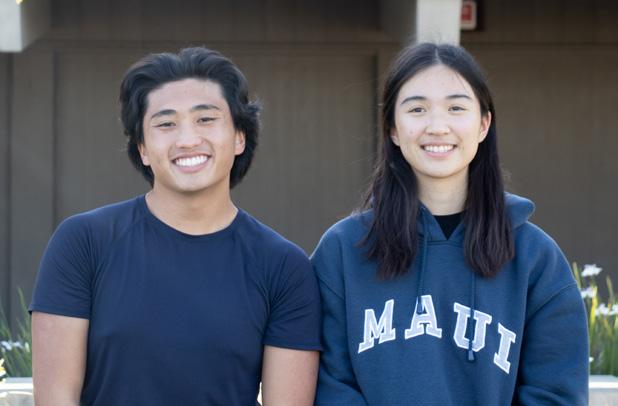
Letters from the Editors
!Qué pasa, Vikings!
We are Myles and Susanna, your Editors-in-Chief, and we’d love to welcome you to the Epic’s Issue 6!
In News, stay up to date on new developments introduced at the Teen Resource Fair; in Opinion, commend the administrative efforts of class officers; in Features, explore the unique careers held by teachers before entering education; in In-Depth, traverse the cleverly cunning concept of satire; in Sports, opinate on the new allowance of double touches in women’s volleyball; in Web, deep dive into the backgrounds and stories of local firefighters at lhsepic.com.
The month of March, verdantly lush
Though bright and purple April trails
Where rich red roses prick cheeks flush Satire and chesire’s kitten tails
Striped with signs of paradox
Wake to scheme and machinate
As truth lies starkly through each fox With cunning teeth, no candor awaits
The stately April’s glassy ghoul Who slinks and stymies every fool
Happy April Fools’ Day!
Poem by Surya Saraf and Riki Murase.
¡Nos vemos!
Myles Kim & Susanna Tang
Editors-in-Chief
FUHSD implements new recycling program across schools
BY ALEX COTTEREL
Since the beginning of January, a new district-wide program has been implemented to help clean up FUHSD schools. Started by the district Climate Collective, the Paper Recycling Initiative works with clubs whose members volunteer to empty recycling bins from classrooms around each campus and gain volunteer hours in the process.
The FUHSD Climate Collective, a program run by students, has been working toward increasing sustainability throughout FUHSD schools. In October 2023, members of the program investigated where paper recycling was ending up across the district. They found that some schools had individual recycling programs, but most had none and recycled items would end up in the trash. For instance, a study conducted at Cupertino High School discovered that about 2.7 million sheets of paper had been used during the 2022-23 school year and had gone straight into dumpsters.
“In our time, sustainability is really important,” junior and co-lead of the Lynbrook Recycling Initiative Daphne Zhu said. “Making sure paper recycling is actually getting recycled is an extremely easy, feasible first step to achieving that because it’s our part in reducing the amount of resources and materials needed to produce paper.”
In response, the Climate Collective began organizing a way to standardize recycling across the schools. The initiative has recycling leads at each school. Zhu and juniors Medha Nalakonda, Kimaya Pantvaidya and Dishita Aeron — all members of the Climate Initiative — are co-leads who manage the collection process and volunteers at Lynbrook. The majority of the district began implementation of the new program in late January, and Lynbrook began in early March. Prior to the program’s implementation, culinary arts teacher Megan Miller’s Training For Transition class and the SOAR (Students Opportunities Achievement Responsibilities) class already
ran a program in which students collect recycling weekly. After meeting with Miller to find ways to work together, the groups decided on a rotation that would benefit all parties.
The new program at Lynbrook involves students from Lynbrook’s Conservation Action Association and California Scholarship Federation clubs. Students participate to earn a volunteer hour for each shift on Fridays to remove the recycling from the print center, library, ASB den and GSS buildings on Fridays. They collect the large amount of recycling that is built up after Miller’s class and the SOAR program cover the buildings on Wednesdays, as well as a first round for the new science building. Students roll recycling bins from the gym to each location. They then look through the recycling to ensure that there are no contaminants and dump them into the large bins behind the basketball courts. If a contaminant is found in the recycling, the entire contents of the recycling bin must go in the trash.
educating students and faculty about how to properly dispose of recyclable materials. The Collective has reached out to teachers, asking them to share guidelines with their students about what to put in trash and recycling.
“A kid puts a juice box in the recycling, and then you have to throw it all in the trash because with contaminated paper, the entire lot gets wasted,” said Monta Vista science teacher, FUHSD Science Lead and member of the FUHSD Climate Collective Kavita Gupta. “So a big part of this was educating students and staff. We talked to some teachers and asked if they can share this information with the students. Just one announcement is an important touch.”
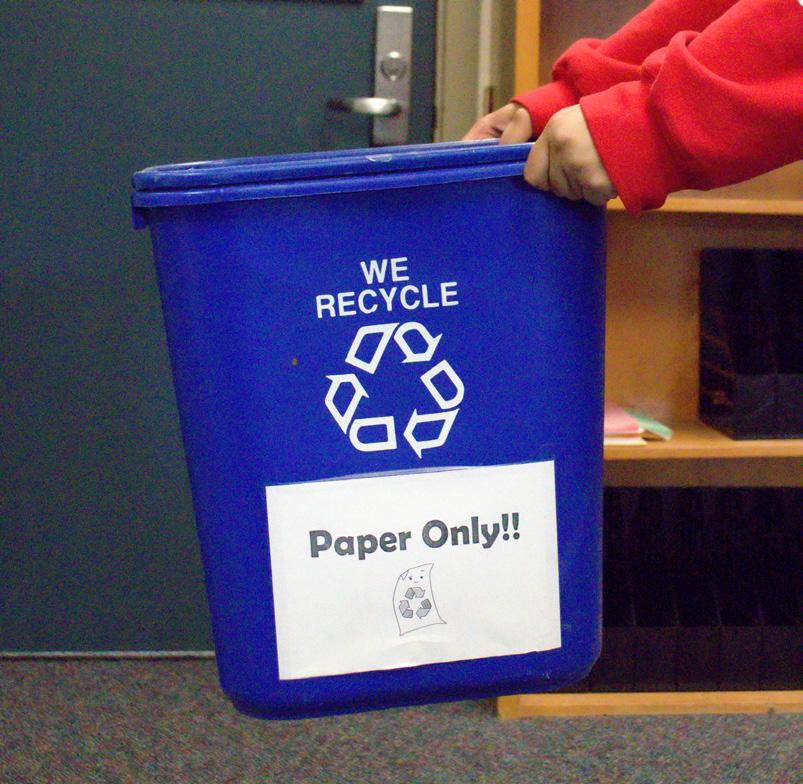
The Recycling Initiative at Lynbrook hopes to expand the program to more interested students.
“Within the next few months or so, we’ll be wanting to open participation to other clubs with volunteering programs and any other students,” Zhu said. “We’re hoping to get as many people as we can and encourage other students to recycle properly.”
“If we don’t have enough people working during a shift, it can take one student triple the amount of time it’s supposed to,” Nalakonda said. “We really want to emphasize that it’s a responsibility from the student side for those who sign up to collect the trash. It’s a team effort.”
Another key aspect of the Climate Collective’s approach to recycling is
The new program provides an opportunity for more students to maintain the campus and learn about sustainability as volunteers help keep our campus clean.
“Starting small with recycling at Lynbrook will hopefully encourage students to say something more in their own communities outside of school, and help sustainability to branch out past just Lynbrook and FUHSD,” Nalakonda said.
Mock Trial team competes at CRF California Competition
BY ERIN FITZPATRICK
The Mock Trial team finished in 13th place at the Teach Democracy Constitutional Rights Foundation Mock Trial competition in Los Angeles, California — the first time Lynbrook has made it to the state competition in five years. After weeks of competition among many schools, the champions of 37 different counties across California were chosen to compete in this year’s state competition. From March 22 to 24, Lynbrook faced four other teams from across the state.
At the competition, Lynbrook presented the mock case of People v. Clark, which follows Tobie Clark, a general counselor for the medical technology company Sunshine Medical Components. Clark is charged with the murder of SMC’s Chief Executive Officer, Kieran Sunshine.
To prepare for this event, Mock Trial members ran 3-hour practices every Tuesday and Thursday after school, oftentimes running even longer.
“The packets that we get for the overview of the case are extremely ambiguous,” junior Ashwin Kamchetty said. “So what we have to do is come up with our own theories, like what we think occurred on the day of the event.”
They also participated in scrimmages with other schools in Menlo Park, Moreau, Santa Barbara and San Francisco. On January 6 and 7, the Lynbrook team hosted the Bay Area Bash, a competitive scrimmage with various teams from across the state. Through these scrimmages, the students acting as the trial attorney team worked on speaking more comfortably in the
courtroom and improving their quick thinking and responses to objections. Meanwhile, the students acting as the witnesses enhanced their persuasiveness and answers during examinations.
“We begin with a story that draws the judge and scoring attorneys in, whether that be through a moment in time, such as the act of killing, or a description of something exonerating what another witness said on the stand,” senior Kyrsten Su said.
The team consists of two sides, the prosecution and the defense. The prosecution argued that Clark murdered Kieran because Kieran decided to pull out of Clark’s plot
to commit fraud against SMC’s board of directors. The defense argues that Clark never had any motive to kill Sunshine, and that he was never inside Kieran’s suite after the murder.
On the first day of the tournament, Mock Trial members arrived at the opening ceremony, where they announced the first pairings for the competition. The rest of the day was spent on team bonding and preparation for the real trials the following morning.
“The first trial started at around 8 a.m. and our last one ended at around 8 p.m., so it was roughly 12 hours in a loud, bustling courtroom,” sophomore Jessie Zhu said. “We had a lot of people watch us do our trials, and it was honestly very rushed.”

Although the team was unable to finish within the top eight, they demonstrated determination and commitment that showcased how much effort they put into being contenders. Many of the team members were seniors, and as this was their last year of competition, they were eager to succeed.
“During COVID-19, our coach recruited more freshmen than usual,” Kamchetty said. “So these COVID-19 freshmen are now seniors, and they’ve been working up to this moment their entire high school career.”
In the end, the Lynbrook team placed 13th out of 32 teams. The team will use this experience as motivation to continue to improve and work toward greater success in future tournaments.
“In mock, you spend hours upon hours with the same people doing the same thing,” Kamchetty said. “The team has a really strong bond, and at the end of the fourth trial everyone was quite emotional, even the coaches.”
02 NEWS
Team A takes poses before winning the fnal round of the Santa Clara County competition against Prospect High School, which allowed them to qualify for the Teach Democracy CRF Mock Trial state competition.
PHOTO BY AUDREY SUN
Volunteers pick up recycled paper weekly from diferent classrooms and collect them in a larger bin by the basketball courts.
PHOTO USED WITH PERMISSION FROM MARK SHEM
PHOTO BY ANUSHKA ANAND
BY ANUSHKA ANAND
Campus, community and world events to note School

Lynbrook Science Olympiad participated in the Santa Clara County Regional Championship at Milpitas High School, where 36 teams from 22 high schools competed. Lynbrook’s two teams placed fourth and seventh overall, qualifying them for the NorCal State Championship. Senior Manank Doshi and sophomore Vyaas Baskar won first place in Detector Building; junior Thomas Wu and freshman Ian Chen won first place in Dynamic Planet and junior Chris Liu and Baskar won first place in the Optics challenge.

National
The House of Representatives passed legislation that would ban TikTok if its China-based parent company, ByteDance, doesn’t sell its stake in the platform, due to concerns over the privacy of its users. Following a 50-0 committee vote, the House floor passed the bill with a 362-65 vote in March. However, senators and other lawmakers have expressed skepticism regarding the impact of the bill on millions of the app’s users. Passage of the TikTok bill would require a majority vote from the Senate.

Community
After years of Indigenous-led advocacy, the Berkeley City Council voted to return 2.2 acres of land to the Ohlone community, which settled there more than 5,700 years ago.
The decision to transfer the land title to the Sogorea Te’ Land Trust is another step in the ongoing efforts to restore Indigenous land rights. Site plans includes establishing a commemorative park with a shellmound and a cultural center to house cultural artifacts and facilitate educational programs about Indigenous communities.

International
On March 22, armed assailants barged into a large concert hall in Moscow, Russia, resulting in the deaths of over 60 people and injuring 145, 115 of whom were hospitalized and five of whom were children. The attack took place as crowds gathered for a performance by the Russian rock band Picnic. Assailants set fire to the venue and attacked the concertgoers days after President Vladimir Putin was re-elected by a landslide in the Russian presidential election that ended on March 17.

Upcoming Viking Events
Spring Egg Hunt, April 1-5
One thousand colorful eggs and eight golden eggs will be hidden around campus for students to find and exchange for prizes.
Farewell Rally, April 5
The final rally of the year will send off the Class of 2024 with exhilarating cheers and activities in the gym during tutorial.
Students vs. Teachers Dodgeball
Game, April 12
Students and teachers will compete head-to-head in a dodgeball game as a fundraiser during lunch in the gym.
Spring Break, April 15-19
Senior Prom Fashion Show, April 5
Students will be showcasing formal outfits to promote the upcoming senior prom.
City of Cupertino and Intra-District council host Teen Resouce Fair
BY OLIVIA YUAN
The Teen Resource Fair took place on March 16 at Main Street, Cupertino. A product of a partnership between the City of Cupertino and the FUHSD Intra-District Council’s Wellness Council, it introduced attendees to volunteering and job opportunities, as well as mental health and wellness resources.
“I was looking for mental health volunteer opportunities,” junior Caitlin Zhou said. “I want to be a psychologist when I enter the field, so I thought it would be useful to come to the fair.”
Various booths and activities were situated on the lawn of Main Street, including a group yoga session led by Fremont High School’s Yoga Club. Booths from IDC and the city’s Youth Advisory Board and Teen Commission — another committee involved in organizing the event — were also present. External partners included the statewide Tobacco Use Prevention Education program and local youth wellness-based nonprofit organizations Health Connect and the Taarika Foundation.
“It’s really important for teens to gather summer volunteer hours toward areas they’re passionate about,” sophomore and Teen Commission vice chair Joyce Cheung said. “I feel that it’s really crucial for them to gain experience outside of academics and find different extracurriculars, both for fun and for their future.”
However, some attendees felt that there was still room for development.
“Many of the job opportunities there had an age limit of 16 and above, and most of us are still 14 or 15,” freshman Isabella Chiu said. “I would have liked to see more diverse opportunities to make the fair even better and more inclusive to various parts of our community.”
In past years, the city has hosted annual job resource fairs; the most recent iteration was 2023’s Summer Jobs Fair. Likewise, events promoting mental health resources are not new — the city’s Bobateeno event has been a yearly fixture with a consistent reception. However, the Teen Resource Fair is the first event in recent years to encompass both fields with an additional focus on volunteering.
The fair was a product of convergent goals.

Last August, while YAB began preparing this year’s annual resource fair, IDC was developing plans to host a wellness fair. November saw IDC secretary, YAB administrator and Wellness Council chair Dhruti Halambi connect the two committees for a mutually beneficial collaboration.
“It was a perfect partnership for us,” City of Cupertino recreation coordinator Robert Kaufman said. “Mental health and wellness is an important topic, especially with the pandemic and all the stress that kids face trying to get through school and prepare for their future. It’s something that we try to bring to as many events and programs as possible. We weren’t initially sure how it was going to be a part of this event, but IDC did a great job of providing it.”

Working with the City of Cupertino allowed IDC to reach a larger audience for a livelier event. IDC and YAB members attribute this partially to the fair’s location on Main Street, a high-traffic venue that the city booked successfully.
“IDC’s biggest aim was to push out as many quality mental health resources to as many people as possible,” Halambi said. “We were looking for a space with a lot of traffic, an event that everybody in the community could come to and have fun at, and the opportunity to exchange all these resources. I think we hit all three of these goals with this fair.”
The YAB communicated with divisions within the city and county, including Cupertino’s Parks and Recreation Department, to roll out volunteering and job opportunities. The Wellness Council tied in local organizations with the guidance of its co-adviser and district associate superintendent Trudy Gross.
The collaboration proved crucial to the fair’s success, which came to be despite its spontaneous inception and other obstacles that abridged the organizational timeline.
“Winter break and everybody getting sick definitely cut some of the planning time shorter than expected in certain places, but with what time we had, we really put together a lot,” Kaufman said.
YAB and IDC were both part of the promotional and fundraising cycle in February and March.
“YAB is very diverse; our members are from many different schools in our area,” YAB outreach specialist Tashvi Bansal said. “Since the fair was held in partnership with IDC, it was also posted in lots of emails from schools. I think these are some of the leading factors behind the good turnout.”
The committees’ district-wide presence and the bustling locale resulted in a turnout that exceeded the expectations of all groups involved. It drew in a bigger crowd than last year’s Summer Jobs Fair and is one of the Wellness Council’s largest events to date.
“The reception was surprising,” Health Connect Vice President Abigail Callahan said. “I don’t think we understood how many people would be there, but everybody who came seemed really interested and excited about what was going on.”
From the attendees’ perspective, part of the event’s appeal came from its in-person nature, which made resources and opportunities more accessible compared to other means.
“I think it can be really difficult to find opportunities online,” sophomore Jessica Steiger said. “You have to search a lot. But when you come to the fair, they’re presented to you and it’s a lot easier to immediately find what you’re looking for.”
The event’s volunteering and job aspects were not the sole recipients of attention. Many also flocked to booths promoting health and wellness.
“Since AP season and finals season are coming up, many students wanted to know how they could connect with their school counselor or find other wellness resources, like hotlines,” Halambi said. “We had many people asking IDC about that.”
Members of YAB and the Wellness Council hope to make this fair an annual occurrence. Future iterations will likely see a greater diversity of booths from both the city and external organizations, including various clubs from every school in the district. Mental health will also remain a central focus of the fair.
“In the future, IDC wants to keep repeating this fair alongside the City of Cupertino,” Halambi said. “I think the overall mission is so needed by our community.”
03 NEWS April 1, 2024
Photo and reporting by Amanda Jin.
PHOTO BY ALEXANDER ZEMLIANICHENKO/AP
Students visit booths to learn about volunteer and job opportunities and mental health resources.
PHOTO BY OLIVIA YUAN
PHOTO BY OLIVIA YUAN
PHOTO BY JEFF CHIU/AP
PHOTO BY J. SCOTT APPLEWHITE/AP
PHOTO USED WITH PERMISSION FROM AMANDA JIN
Technology and literature clubs merge to join common interests

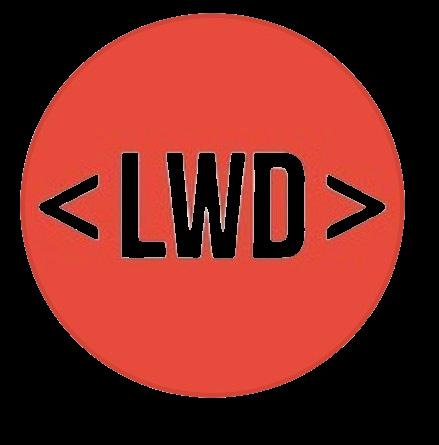
Web Development Club
Web Development club has merged with Mobile Development club, allowing members of each club to combine their collective skills. Web Development is known for teaching students how to develop websites as well as for designing websites for Lynbrook organizations and clubs, such as Lynbrook Excellence in Education; Mobile Development Club is more focused on assisting students in learning how to construct their own applications.
The idea for a merger sprung out of the realization that Mobile Development and Web Development clubs covered overlapping topics. App development on computers and cell phones can be similar, so they decided that both clubs could benefit from a merger.
“Now that we have different topics, we have more latitude,” Web Development President Anish Lakkapragada said. “I think that’ll be really beneficial going into next year, which is really exciting.”
The two clubs had many concerns about merging, the most relevant of them being the timing of meetings. Since Web Development normally met
that some members wouldn’t be able to attend meetings. However, the club decided that the new members would still attend meetings due to their interest in the subject.
There was also the issue of assigning new officer roles. With new members and a larger focus on mobile development, the clubs wanted to make sure that all groups were represented in leadership. Web Development has created a new position specifically for Mobile Development, where certain officers will be dedicated to the production of mobile projects.
“Having specialization and diversity in the officer team for next year will be crucial to take advantage of how we have many more subjects to work on, ” Lakkapragada said.
Now that the clubs have merged, the officers hope to continue making and maintaining their many websites and projects. They also are hoping to implement a new system to ensure that members can more easily learn to develop their skills through various projects.
“Now that we have so much more to work with, we hope that we can help develop apps for clubs on campus,” Lakkapragada said.
Students For Literacy
The Science Fiction club decided to join with Students for Literacy this February. Sci-Fi club, known for its appreciation for popular culture and science fiction, decided to merge after witnessing a significant decrease in club meeting attendance.
Students for Literacy encourages reading and interest in literature among students. The club officers found out about Sci Fi club's issues through librarian Amy Ashworth, the adviser for both clubs.
“We were doing the same as them attendance wise,” senior and Students for Literacy President Ella Yuan said. “Because our focus is broader than theirs, as science fiction falls under literature, we ended up absorbing them and not the other way around.”
All clubs receive strikes when their attendance drops below 10 members for any given meeting, which can lead to the school administrators dissolving clubs. Sci-Fi club’s low attendance concerned officers. Following Ashworth’s suggestion to merge, both groups met in December to discuss next steps.
“We discussed the club size problems,
the officer positions and the meeting time, because there are time conflicts every day. Choosing days when people were available was hard,” junior and SciFi club President Galen Han said.
Both officer teams eventually agreed on a compromise: Students for Literacy officers would maintain their positions, and Sci-Fi club officers would be instated as interns.
Now that the two groups have merged, they plan on incorporating both science fiction and literature elements into future activities and meetings. In the few club meetings that they have held since their merger, members have been able to discuss topics such as the “Three Body Problem,” a popular science fiction series. Members of Students for Literacy have received the merger positively, welcoming a new genre to focus on and new students to collaborate with. The club also hopes to offer more officer roles to the new members of Sci-Fi club, aiming for proper representation in the club’s leadership.
“We want to be able to create balance when we choose all new officers,” Yuan said. “We are planning to try to include the Sci-Fi members as much as possible, while also giving our members a chance at achieving club leadership.”

Students join world’s largest rocket-building competition
BY EMILY PEDROZA
Seven students from Engineering and Aeronautics club are participating in the American Rocketry Challenge, the world’s largest rocket-building competition — with more than 5,000 applicants competing every year — that asks participants to design, build and launch rockets using engineering knowledge and skills. The final submission dates for their rocket and their marketing campaign, a filmed process and launch documentary, are on April 8 and 14, respectively. The teams that qualify will then move on to national and international comeptition brackets.
The team formed after junior Meadow Shen discovered the competition’s website in early February and soon found members interested in participating from Engineering Club and Aeronautics Club. Many members found the topic, aerospace, intriguing as there aren’t many perceived
opportunities for people to gain hands-on experience in the field. Gathering over breaks, tutorials and weekends, the team’s efforts coalesced to meet the competition deadline.
The team’s current goal for the project is to have the rocket hit an 820-foot altitude in 43 to 46 seconds; thus, they have to find new ways to build the rockets and optimize them. So far, the team has worked together to build or print 3D pieces that make up the main body of their first rocket and is working on an airbrake, which uses air pressure to adjust the acceleration of their rocket. Throughout the creation process, they have designed the prototype on rocket simulation software, bought or 3D printed the individual parts, assembled the rocket and are currently scheduling their trials at launch sites.
“We’re all really dedicated to this project,” sophomore and team member Xiaoya Gao said. “We’re on a good pace because we’re all enjoying the competition, trying out things
we usually don’t get to try.”
A longstanding challenge has been finding a test launch location they could visit to launch the rocket, as most of the locations are very far away and the closest being a round trip of over three hours. With the large amount of time needed, scheduling and communication becomes everimportant with all members having to agree on a time to meet and transportation methods.
“We were supposed to go test the rocket one weekend, but it got canceled,” mathematics teacher and Engineering Club adviser Vivian Frazita said.
Soon after the team installs its airbrakes, the first rocket will be completed, after which they hope to piece together a second rocket as a backup.
“I’m proud of the progress we’ve made,” said senior Vincent Chen, a participant of the American Rocketry Competition team and president of the Engineering Club.

April 1, 2024 NEWS 04
Participating students meet at Cupertino Library to glue together their rocket for the competition.
Ofcers of Students for Literacy, a club that encourages interest in literature, promotes their organization to attract new members.
PHOTOS USED WITH PERMISSION FROM ELLA YUAN
PHOTOS USED WITH PERMISSION FROM MEADOW SHEN DESU W I T H P E R M I SSION FROMANISHLAKKAPRAGADA
The design of the students' model rocket on the online RockSim simulator.
e importance of empathy for class o cers
From behind-the-scenes projects to class-wide events, class officers are the backbone of making plans a reality. They represent the voice of the student community by generating ideas, organizing events and overseeing activities. Despite their efforts to accommodate the student body’s best interests, they receive frequent backlash in response to their actions. It is crucial to recognize that class officers grapple with factors such as time and monetary constraints that students may be unaware of, leading to unfair criticism.
Class officers are tasked with a variety of responsibilities interspersed with weekly meetings with other officers and advisers. Each event starts with the formulation of ideas, discussion of feasibility with the admin and advisers and careful planning.
Even with meticulous planning and consideration of these many aspects, proposed events do not always run smoothly.

a vital role in decisionmaking, as these events are costly to prepare and put into action. From the venue to catering, almost all aspects of Junior Prom were set, yet unforeseen obstacles can cause lastminute adjustments. Although some junior students may have felt that their prom event would be unsatisfactory with the addition of sophomores, the experience was no less remarkable. With this decision, the class officers are more likely to receive enough money to maintain the quality of their future events, such as Senior Prom.
Staf Editorial
The Voice of the Epic
responsible for the final call. Simply accusing class officers
of making unfavorable decisions is not a productive way to solve the actual issues.
“I think one of the things to keep in mind is that a lot of the power and the decisions that are being made aren’t from us,” Class of 2026 President Samay Sikri said. “We’re the messengers; a lot of the actual decisions come from administrators.”
and leadership skills, it is important to remember that class officers have a life outside of the school community, and uninformed comments associated with their decisions on class events can be upsetting and further increase pressure on class officers.
“They’re trying to make decisions for what they think is the best for their class,” ASB adviser Anna Kirsh said. “But it’s also important to remember that for a lot of them it’s their first time in school leadership positions. At the end of the day, all of them are students and one of the difficulties is having to make these very big, very public decisions. They’re doing the best they can with their experiences.”

“They’re trying to make decisions for what they think is the best for their class.”
Oftentimes, the success of these decisions depends on external circumstances that cannot be controlled, such as budget, time constraints and the class’ expectations. The school and class officers hold limited amounts of money, much of which comes from donations and fundraising sales events.
Anna Kirsh, ASB Adviser
“There’s a lot of stuff that happens behind the scenes that people who aren’t class officers don’t really get to see. There’s a lot of things that need to happen for an event like Junior Prom,” Class of 2025 adviser Luca Signore said.
In the light of recent complications with Junior Prom, officers faced clear difficulties. The initial expectation of 300 Class of 2025 participants translated to only around only 215 ticket sales, presenting a significant financial challenge for the class. If the class officers, class advisers and admin decided to move forward with only juniors attending, the class would receive less funding than what would be necessary for future events, such as Senior Prom. After extensive discussions and input from admin, the junior class officers decided to invite sophomores to increase their funding levels. The invitation was not extended to seniors due to concerns that cheaper Junior Prom tickets would detract from Senior Prom attendance. This decision sparked backlash across the student community on social media, with students demanding that future class officers refrain from making the same decision.
“During the entire situation, we were all on a call for four hours trying to figure out a solution,” Class of 2025 officer Dishita Aeron said. “It’s definitely hard for the people commenting on our decisions to know what goes on behind the scenes.”
This outcry can be understood, as an experience marked as uniquely “junior” was including underclassmen. However, it is important to consider that budget plays

Class of 2024 and 2023 officer teams have also had their share of obstacles. The company who printed the senior shirts for the Class of 2024 misprinted the shirts, deviating from the traditional senior shirt design. Some students were upset, but the change posed no significant diminishing of class spirit. Ultimately, the class officers decided to keep the shirts as they were, although a second round of reprints were offered to any interested seniors.
“One of the things that you realize when you’re making such big decisions for large groups of people is that there are different aspects to consider and it’s hard to make everyone satisfied in the end,” Class of 2024 Vice President Derek Li said.
The Class of 2023 faced backlash for their decision to end the Lynbrook tradition of holding prom on the Hornblower cruise ship. This decision was influenced by bookings errors and fears surrounding the possibility of COVID-19 outbreaks. After discussions of alternative plans, including combining Junior and Senior Prom, the officers ultimately decided to hold Senior Prom at a large land venue. This, in addition to the high price of the land venue resulted in widespread discontent among the senior students.
“I think the comments that we received started getting a little bit personal and harsh,” Class of 2023 Vice President Arushi Gupta said.
It is easy to push the blame onto the class officers, criticizing what some perceive to be inadequate decisions. Nonetheless, the majority of the student community do not have the complete perspective of the causes behind the decisions. Although class officers contribute to the decisions, administrators are largely
editors-in-chief — myles kim, susanna tang
managing editor
— anushka anand
Even then, administrators have the students’ best interests in mind, and any unpopular decision was made to combat technical concerns. Creating a scenario in which everyone is fully satisfied is impossible, and compromises must be made in order to preserve the quality of the future events. Additionally, class officers may have a better idea of student dilemmas than students give them credit for.
“You can’t judge a situation based on just one event, you have to know the entire context of what’s going on,” Class of 2027 President Aarav Anand said. Students should instead seek information when confused or strongly opinionated regarding class events. The class advisers and ASB adviser Anna Kirsh welcome inquiries, and informed in-person suggestions towards the class officers will produce a more effective outcome compared to harassment and criticism. In the past, class officers have gathered feedback through forms on social media, and sought advice from previous class officers.
“If the students are having fun and able to do what they’ve proposed, it’s time well spent and I feel like I played a part in making their school life a bit better,” Class of 2026 adviser Kevin Tran said.
Despite their extensive responsibilities
It is crucial to recognize that student officers are elected through vigorous levels of campaigns, in which their capabilities are weighed by the student population. Those who are chosen possess key qualities which make them effective decision makers for the student community.
“I want to emphasize the difficulty of planning these large-scale events for the entire class,” Assistant Principal of Activities and Athletics Yukari Salazar said. “Be kind to your officers. You elected them for a reason.”
Especially during difficult times, it is important for students to appreciate the work of class officers, who are doing their best to represent their voices and make the high school experience truly the best it can be.
“There were bumps along the road, but they were able to turn things around quickly,” junior Kylie Liao said. “I think they did really well managing all the stress and still being able to put this huge event out there.”
the Epic staff voted 39-0 in favor of this stance.

stafers
news editor — apurva krishnamurthy opinion editors — alyssa wang, lilly wu
— eileen zhu
sports editor
— ashley huang
taek kim
alexandra wu
alex cotterel
amanda jin audrey sun
claire guo web editors in-depth editor
charlotte bolay
— daeun chung, qianzi loo
copy editors — katie chin, surya saraf — deeksha raj
— chelsea lee, valerie shu
business/pr manager features editor — emily pedroza
design editors adviser social media manager — riki murase
— josh miller
crystal zhu david zhu erin fitzpatrick gary pan
grace zhu inaaya yousuf
valued contributors: Soo Yeon Choi and Lisa Liu
irene hwang
meadow shen
nicole ge robert yu
rohan kakhandiki
sarah zhang
vidushi upadhyay
vihaan patel olivia yuan
yvonne wu
05 the Epic OPINION
small print: the Epic is the official newspaper of Lynbrook High School and is a student-run open forum not subject to prior review, as protected under the California Education Code. Views expressed in the Epic do not necessarily reflect or represent those of the administration or faculty of this school or district. Letters to the Editor, guest columns and other materials to be considered for publication are welcome. Visit lhsepic.com/submissions for the guidelines and submission form.
studentbody class ofcer
GRAPHIC ILLUSTRATION BY CLAIRE GUO AND ALYSSA WANG
Are consumer boycotts actually e ective?
e adverse impacts of boycotting
BY DAVID ZHU
In recent decades, consumer boycotts, which occur in order to hurt companies for their stance on certain political issues, have gained traction. Thousands of people around the world use consumer boycotts to advocate for social and political issues that they are passionate about. However, in the process of advocacy, boycotters often fail to think about the destructive effects their boycotts end up having on the working class and consumers. Many boycotts in the past did not continue on for long enough with enough people to participate, proving to be ineffective. Rather than solely focusing on boycotts, advocates should take use of more methods including direct communication to their local, state-wide and national government offices.
The practice of boycotting was first recorded in the 1790s, when British abolitionists boycotted West Indian Sugar for its support of the slave trade. Since then, boycotts have been used to advocate for a variety of issues. In the past few months, boycotts against McDonald’s and Starbucks have rapidly grown in response to the conflict in Gaza. Boycotts easily gain online traction, and due to the vast amount of people using online platforms, these movements are able to grow in a relatively short amount of time.
“Lately, we’ve seen an increase in boycotts that became very popular,” Jamilya Ukudeeva, an instructor of political science at West Valley College, said. “Social media makes it easy to disseminate information, and there are no
gatekeepers in terms of information, making these campaigns very easy to spread.”
The impact of boycotts are difficult and impractical to measure. In the past, large movements that wasted both energy and time ultimately resulted in little political and social change. For instance, when Chick-Fil-A was boycotted due to its controversy with the LGBTQ+ community, enough customers continued to eat there that it eventually outlived the boycott. It is impossible to quantify the amount of people and the time it takes for boycotts to significantly disadvantage a company.
“It’s often hard to measure the effect of boycotts on multi billion dollar companies,” sophomore and Politics Club officer Vikrant Vadathavoor said. “A lot of advocates are very reactionary and often forget about the social issue a few months later, and in the long term, some of these movements don’t help out that much.”
Although boycotts seem like an effective way to advocate for political issues, what’s often neglected are the numerous adverse effects they bring upon the working class. The interests of companies don’t necessarily represent the interests of their employees and the people that the organization serves. Thus, when companies are massively hurt by boycotts, the hundreds of
thousands of people employed by the company are devastated by wage cuts and job loss. Many of these workers rely on the income from their jobs to support their livelihoods and families, and the layoffs will deprive these minimum-wage workers of their source of income. When boycotts against Target, Disney and Anheuser-Busch occurred, the companies themselves were largely unaffected while the employees bore the economic brunt. In the recent boycott against Starbucks, the company was forced to lay off 2,000 employees across many of its chains in the Middle East and North Africa.
Unfortunately, because many people from the younger generations join large boycott movements through social media, where the method of protest is to stop buying products from certain companies, less and less attention is being devoted to finding more effective ways to bring about substantial change. One of the most important methods of bringing about substantial policy change and a vital part of the US democratic process is voting, which a large portion of
America’s youth is currently neglecting.
“Our voter turnout in America is one of the lowest among democracies, especially among the youth,” Ukudeeva said. “It doesn’t take a lot of time from your day to vote, to call, to write letters to government officials or to attend board meetings. It’s so easy, so make it a habit.”
Boycotts can work. We just think they can’t.
BY MYLES KIM
How do we know that boycotts work?
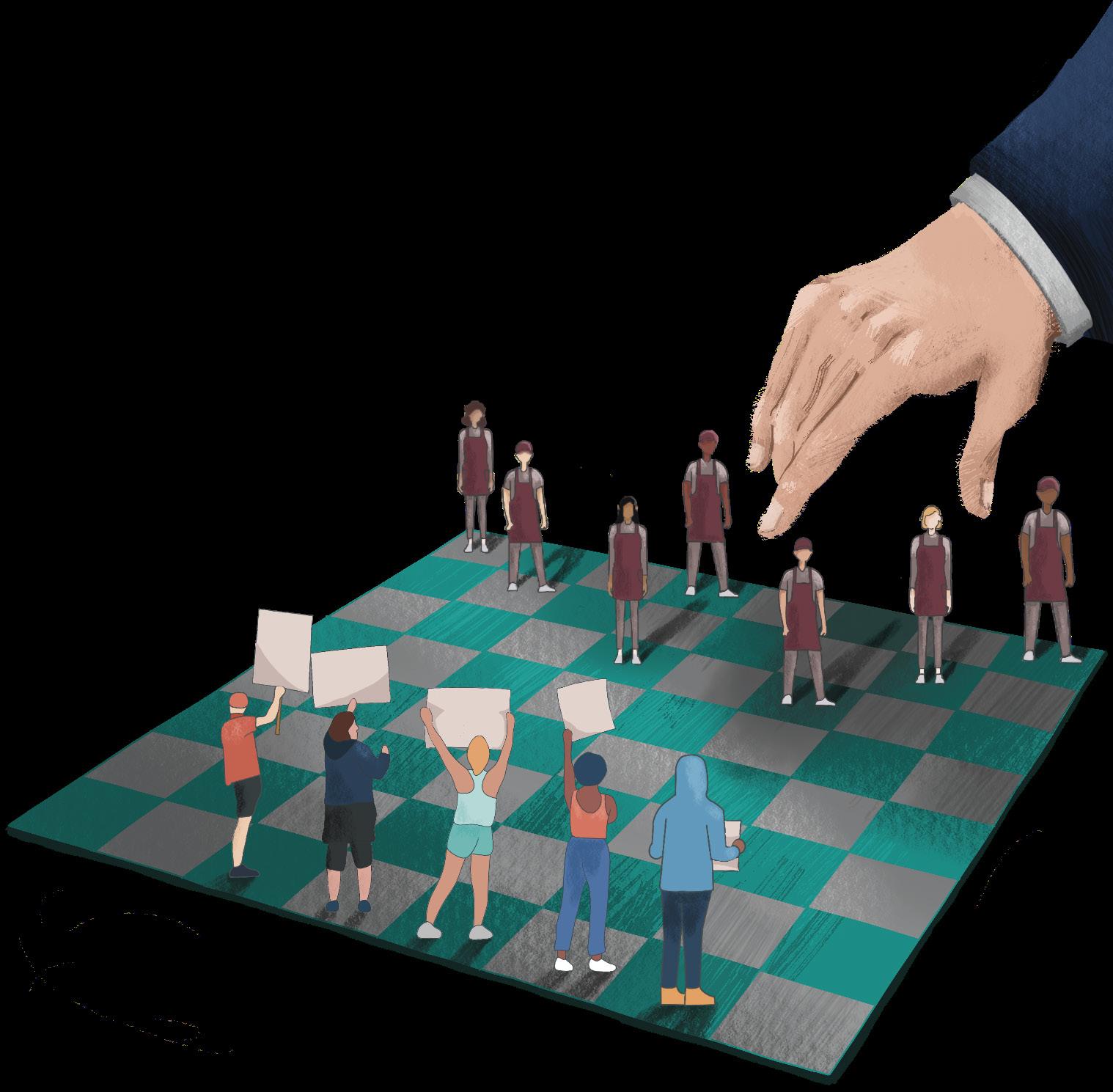
Because we live in a country that was founded on them. Repeated economic boycotts of unfair British colonial policies gave birth to the American revolutionary movement, and those same principles of broad civil disobedience are what pushed African Americans to advocate for themselves during the Civil Rights era, molding this country into a more democratic and inclusive society. Today, the right to boycott, most often realized in today’s world by consumers’ refusal to buy the products of a targeted organization, is almost synonymous with American political culture.
“I think boycotts send an important message to companies,” West Valley College political science instructor Jamilya Ukudeeva said. “That’s why companies are making sure that they’re ethical and that they pay attention to the culture of a particular society.”
The word “boycott” is derived from the name of the infamous landlord bootlicker, Captain Charles Boycott, who tried to evict farmer tenants during the Irish land war in the 1880s, for failing to pay their rent. In response, the community ostracized him, his laborers and servants abandoned their posts and his crops were left to rot. In this era of globalization, economic co-
dependency and rising regional conflicts, Captain Boycott’s deserved demise teaches the grassroots organizers of today a crucial lesson: don’t mess with the working class. The single greatest unifying characteristic of the most effective boycotts throughout history are that they stem largely from grassroots and working class origins.
The Montgomery bus boycotts, and subsequent boycotts of motels, restaurants and other segregated establishments were not only initiated from a position of oppression and destitution, but also succeeded in giving the civil rights movements the momentum they needed to continue their fight against discriminatory policies for the following 20 years.
According to the National Park Service, over 90% of Black residents participated in the 381-day boycott, and it resulted in an estimated loss of 30,000 to 40,000 fares daily to the bus company. In fact, the boycott was so effective that leaders at the company were almost immediately willing to sit down to discuss the prospect of desegregating the transit system. However, due to pressure from city officials to retain segregationist policies, the company was forced to continue to endure a deficit of profits until the Supreme Court’s decision on Browder v. Gayle outlawed discriminatory policies in bus seating.
Three crucial lessons about the effectiveness of boycotts can be found in the outcome of the bus boycotts. One, that boycotts can be effective if highly directed toward one single entity or corporation; two, the momentum of a concentrated boycott is more likely to crumble from outside forces — such as a government seeking to preserve the status quo — rather than internal strife or conflict. Most importantly, the success of a grassroots social movement shouldn’t be wholly reliant on only one form of resistance or protest. Broad civil disobedience is crucial to the success of any social movement.
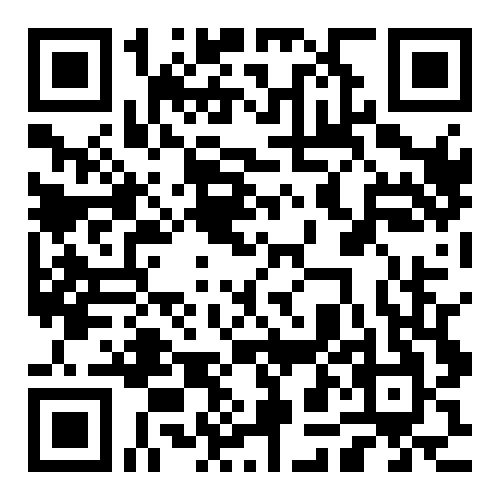
In today’s digital world, ripe with performative activism, the possibility of creating such a concentrated boycott effort is harder, but not entirely impossible. Empowered by one of the most potent culture war issues of this decade, transgender rights, conservatives seized on the marketing blunder that was the Bud Light and Dylan Mulvaney partnership, marking the beginning of one of the most successful boycott movements in recent American history. According to The Guardian, Anheuser-Busch, Bud Light’s parent company, suffered a $395 million loss in North American revenue in 2023’s second quarter as a result of the boycotts, and they ended up laying off 2% of its U.S. workforce — about 350 employees — in July 2023.
There’s no doubt that boycotts can be an effective grassroots tool for progressive change. But like any form of protest, there are bound to be negative consequences — layoffs, shuttered businesses and unsatisfied consumers. While some may view these as inexcusable tradeoffs, the entire point of boycotts is to create that economic discomfort, which has been proven to have been able to force governments to submit to a movement’s particular demands.
Boycotts are a long-term strategy for protest. The ultimate success or failure of boycotts should not only be measured through a lens of the economic discomfort that a movement creates, but more prominently, the lasting impact of a movement’s message in the public town square.
April 1, 2024 OPINION 06
GRAPHIC ILLUSTRATIONBY CRYSTAL ZHU AND DAVID ZHU SCAN ME Read more at lhsepic.com
 BY EILEEN ZHU//IN MY OPINION
BY EILEEN ZHU//IN MY OPINION
Expressing myself through pen and paper
While many of my kindergarten classmates went to lunch ecstatic and hungry, I went to lunch every day on a mission: to make a friend. My dad always advised me to make friends by following the other kids around and copying what they did, so I dug for “crystals” in sand filled with tanbark, pretended to know the lyrics of “Let it Go” and flipped around on the monkey bars, conforming with the other 5-year-olds around me. I was determined to someday discover the secret to making
a friend, even with awkward English and an incessantly high-pitched voice. I have come to realize that learning to write was a form of compensation for my early troubles and sleepless afternoon naps, where dwelling on which conventional and conversational words I used served little help for the next awkward conversation I’d have.
When my first-grade teacher introduced “weekend writing” to us, I thought it was easy enough — I knew how to capitalize the first letter of each sentence, I knew how to dot my i’s and cross my t’s and I knew how to add a period to the end of each sentence. But it wasn’t just about grammar or penmanship as much as it was about a newfound consciousness. I took several minutes to think about each sentence I wrote, recalling my weekend dance class with my sister and the quick ski trips to Tahoe, erasing and rewriting words that would better fit the depiction of my memories. It was evident that the more I wrote, the more I could express my feelings in real life.
According to my teacher, writing was advantageous because anyone could take
as much time as they needed to find the refined words and impeccable phrasing to articulate anything they wanted. Writing in school became my strong suit, since I embraced the endless time to think about forming my thoughts into words, and soon into well-developed essays and narratives. As I progressed through middle school, I learned to write about myself without compromising complexities.
My days in early elementary school are blurry; I don’t have many recollections of specific events or favorite days and I wouldn’t be able to remember when I stopped worrying about my English. Without an iPhone camera or trendy digital photos to capture candid moments, most of us remember our childhoods with feelings. And so instead of wracking my brain to recollect moments of significance, I associate the early obscure moments with the words: excited, optimistic and often misunderstood, literally. Writing became a sanctuary where time was abundant, and so sentences were meticulously assembled into expressive tapestries, all eventually folded neatly into end-of-the-year portfolios.
A language barrier rained on some of
my experiences as a kid, having to grapple with an invisible hurdle that isolated me from my classmates, but the beacon that writing could provide prevented the barrier from weighing down honest expression. Writing eliminates the endless possibilities of being misunderstood amid fast and frequent conversations, especially now that I feel inclined to Thesaurus my way through hazy thoughts.
So what makes writing different to me than speaking, now that I’m fluent in English? It’s easy to simplify and sacrifice honest emotions when we speak, whether it’s in the heat of the moment or a careless minute of small talk. If I guessed and checked words in and out of my sentences out loud the way I do when writing, I’d probably never catch a break or a breath.
After pushing past the misspelled words and scratchy handwriting from my collection of weekend writing entries, I’ve recently remembered what it was like to be five again — eager, anticipating and often dazed. I’ve found better vocabulary to describe, persuade and illustrate my thoughts over time, but it started with a want to be heard clearly.
e detriments of locking truths behind paywalls
BY MEADOW SHEN AND SARAH ZHANG
It’s the age of misinformation: scrupulous journalism and research are expensive to achieve, while fabrication and conspiracies are readily churned out. Due to these costs, many newspaper and academic websites have implemented paywalls, hiding valuable content behind monetary barriers. Genuine news and reporting have often become inaccessible while lies and misinformation take over the media. Thus, paywalls hinder access to credible information and should be replaced with unrestricted, publicly-funded media.
“I didn’t realize how much I was paying for my New York Times subscription,” librarian Amy Ashworth said. “Paying for credible news should not be so expensive.”
With paywalls restricting public access to content, there are often limited news sources available for free. More than two-thirds of leading newspapers from the United States and European Union are paywalled. With these restrictions, a reader may only have access to the articles’ headlines or a few selected sentences from the story. Article headlines are often written to be inflammatory and subversive, and may be misleading if the full context of the story is not offered. As readers cannot see past these paywalls and misleading titles, they may misinterpret the news and information that the article intended to portray.
PBS and NPR, yet neither are as relevant to U.S. citizens as the BBC to British citizens, for instance. A paper published by the University of Pennsylvania found that secure funding for public media systems and protections for their political and economic independence was correlated with healthy democracies.
The proliferation of mass-produced, low-quality articles and shuttering of fact-checked news behind paywalls makes it imperative to know how to navigate the politicized news landscape. A fact can be reported many ways, and readers should constantly verify their understanding of an article with other sources. In addition, reading the headline or the first few lines of an article is never enough — the beginning is always the most thrilling and sensational.
66% of revenue for news media comes from advertising according to the Pew Research Center

Furthermore, paywalls create a barrier between those who can afford to read stories and those who cannot. Marginalized groups, with limited internet access and who cannot afford the subscription fees, are at a disadvantage as they are unable to access the same amount and quality of information as other groups. Currently, there is already an inequality in media accessibility. The bottom 40% of the income distribution accounts for only 20.8% of total spending on reading, including newspapers, magazines and books. As an increasing number of primary news sources get paywalled, those who are unable to afford them are stuck with secondary and tertiary sources, which are more liable to misinformation. Consequently, there is a deepening divide between the privileged and underprivileged.
“Journalism should be free to consume because education is already hard to come by for some people,” sophomore Stephen Florip said. “Paywalls only reduce the amount of information that people can receive.”
In the current media, bias is present in many newspapers, including the popular ones, which has fueled the polarization of stories on many political and social issues. As a result, it is increasingly difficult for readers to find fact-based, neutral sources. Readers are now required to actively interpret news on their own by cross-checking between different outlets or verifying the authors’ credibility. Paywalls interfere with the individuals’ ability to fact-check information, as readers have limited access to available media. Furthermore, many people may not be able to afford the expenses of having multiple subscriptions, and thereby feel discouraged to verify their news. This results in a lack of diversity in news and opinion as people may only be exposed to one side of the story.
Paywalled news is antithetical to public media, and its expansion is detrimental to the health of our democracy. The U.S. has publicly-funded media systems, in the forms of
“A tip I have is to look for primary sources,” Ashworth said. “News outlets are filtered by editors, and thus the information they present may be biased.”
Despite the cost, paywalls can be justified in certain circumstances. People are migrating to digital platforms for news consumption, where quick turn-around drives more engagement and revenue than quality content. While tabloid sites can keep themselves funded with numerous ads, more reputable newspapers have little to no ads that provide revenue. Through paywalls, some argue that newspapers can establish a more stable source of revenue to fund their team of writers, editors, designers and lawyers.
“In-depth research may become expensive with paywalls,” sophomore Kartik Gudapati said. “But by paying, readers are funding the future research of these publishers.”
Although the goal of paywalls is to provide revenue, it is ineffective in achieving that.
According to a Pew Research Center report from 2014, news media got more than two-thirds of their revenue from advertising. Therefore, the monetary contribution made by paywalls is limited, even as the negative effects outweigh the good.
When it comes to bypassing paywalls, the best solution is to utilize the local library. A library card gives access to many news sources that would normally be hidden behind monetary barriers.
“Admittedly, the library interface is not easy to navigate,” Ashworth said. “But the only way to get free
access to paywalled content is through your public library. Get a library card.”
As an alternative to paywalls which limit access through subscriptions, media outlets could implement pay-per-view articles. In this approach, readers are only paying for articles that they want to read, which could reduce their overall spending and improve affordability. In addition, companies could paywall only certain articles, which is what the Mercury News already does. Critical news articles should stay unrestricted, but less-crucial stories such as those on sports or entertainment could stay limited to subscriptionholders. In this way, media outlets could still profit from select articles while maintaining accessibility to important news. There are also platforms and apps such as Apple News and Flipboard that federate content, allowing consumers to read articles and news from a variety of sources. In this way, people are able to read a variety of news — whether left or right leaning, local or national — with a single payment, rather than managing multiple subscriptions over a number of magazines and publishers.
As online media continues to restrict their content with monetary barriers, it is critical to consider the drawbacks of these paywalls. These subscription services perpetuate sensationalism, increase the knowledge gap and restrict the spread of credible information. Through publicly funded media, pay-per-view features, and selective monetization, the news and media industry can work on reducing paywalls and improving the free flow of ideas and information.

07 OPINION April 1, 2024
GRAPHIC ILLUSTRATION BY ANUSHKA ANAND AND DEEKSHA RAJ
PHOTO BY CLAIRE GUO
FEATURES the Epic
Shripriya Kalbhavi develops microneedle patch in medical breakthrough
BY SURYA SARAF
Pharmacologically perplexing theories permeated freshman Shripriya Kalbhavi’s mind as she sat pensively, cross-legged on her bedroom floor, pressure transducer ready to calibrate, marking the next brave leap into her scientific creation.
At 14 years old, Kalbhavi developed EasyBZ, a costeffective microneedle patch that allows for the transmission of drugs without the use of traditional or hypodermic needles.
In eighth grade, Kalbhavi won second place in the 3M Young Scientist Challenge, a project-based contest for students in grades five through eight to describe an innovation or solution to an everyday problem that addresses an issue they are passionate about. After winning a $2,000 prize for her submission video of EasyBZ, which outlines her purpose and process of creating the patch, Kalbhavi was featured in many articles for her achievement. One in particular, published on March 8 by “American Kahani” magazine, named her an “Indian American Trailblazer” in honor of International Women’s Day, along with others such as Vice President Kamala Harris and British Indian actress Ambika Mod.
“Winning second place was surreal to me,” Kalbhavi said. “It gave me a lot of perspective into how many people could potentially be impacted by this patch. I am excited and hopeful for its future developments.”
As a young child, Kalbhavi was one of many with Trypanophobia, a fear of needles. She was determined to explore a painless alternative to disease prevention, one that challenged the norm of traditional vaccines.
“Hypodermic needles are really painful and invasive, and they require someone to actively administer them,” Kalbhavi said.
“My main idea behind this was to make it easy to use autonomously, especially because many people I am targeting as the end users are older adults and younger children with diabetes.”
The patch itself is composed of microneedles —
minuscule, painless needles that penetrate the skin — along with a Belousov-Zhabotinsky (BZ) gel, a swelling polymer hydrogel. This substance oscillates, generating pressure, which is used in the active medication component of the microneedle patch.
“My experiment was originally from a process called the BV oscillating reaction, but it can also be adapted into hydrogels, which is the bulk of what I worked on,” Kalbhavi said. “I was able to bring the idea to life by experimenting with different hydrogels and materials to observe their compatibility in the patch.”
The patch is simply placed on a patient’s skin and activated, allowing the reactants of the gel to mix and induce the gel to swell and shrink in size, thereby forcing the medication into the skin through the microneedles.
“I’ve always been interested in the intersection of biology and chemistry, which I actively studied in my experiments,” Kalbhavi said. “I think there’s a lot that both fields can learn from each other.”

a BZ reaction, polymerization and pressure transducer calibration. She was initially nervous, unsure EasyBZ would become a reality because microneedle drug patches fall under a relatively untapped field.
“When I talked to many scientists, they all told me, ‘Ok, this idea’s kind of nuts,’” Kalbhavi said. “But they said we could give it a shot.”

“My advice for anyone wanting to get involved in science would be to look for a role model.”
Shripriya Kalbhavi, Freshman
After being selected as a finalist for the 3M Young Scientist Challenge, Kalbhavi was matched with a mentor, Dr. P.J. Flanigan, a central resource manager for 3M Healthcare, to help make her patch a reality. When creating EasyBZ, Kalbhavi considered its cost, how easily it could be manipulated, the fact that it could be contained in a small space and other design features.
“My mentor was really helpful; she gave me a lot of insight into the medication delivery field,” Kalbhavi said. “She was able to talk to me about the different challenges people face, having worked with transdermal patches before.”

Nevertheless, Kalbhavi’s experimental process was daunting from the get-go. Acquiring laboratory space as a freshman in high school is no easy task. She considered performing the lab work at home, but many of the chemicals she worked with required the safety of a lab setting. After months of reaching out to private research labs, one of them happened to say yes.
With the help of her plexiglass prototype, Kalbhavi sought to make a bona fide version of EasyBZ involving
Kalbhavi felt frustrated at times when certain aspects of her experiment did not go as planned. At one point, she tried to recreate one of her reactions, which “completely refused to work,” Kalbhavi said.
“The process of going back, figuring out what went wrong and fixing it was both exciting and frustrating,” Kalbhavi said. Her efforts came to fruition following months of experimentation, and Kalbhavi saw enthusiastic support from her parents and younger sister for her second-place win.
“A lot of my friends also watched the live stream during the final event and were super excited to see what came out of it,” Kalbhavi said.
But Kalbhavi hasn’t stopped there. She hopes to formally patent EasyBZ, having received her provisional patent a few months ago. She plans to apply for a nonprovisional utility patent to protect the design idea, eventually gain FDA approval and start clinical testing on its journey to public usage.
“Needle phobia is a pretty big deal with 2 in 3 children and 1 in 4 adults being afraid of needles,” Kalbhavi said. “Getting it out into the market and having it available for use would really change a lot of lives.”
Furthermore, as a woman of color and young scientist, Kalbhavi continues to find similar role models and encourages all young aspirants to do the same.
“A lot of the reason why you don’t see a lot more young women getting into science is because they don’t have enough role models to look up to,” Kalbhavi said. “My mentor was the epitome of the role model that I wanted as an adult in science; I think my advice for anyone wanting to get into science would be to look for a role model who reflects them as a person.”
Kalbhavi hopes to contribute to innovation in the future as a neurosurgeon or other medical professional, but she wants to keep her options open. For now, she simply wants to go into a field that helps others.
“Science is really open to anybody that wants to get involved,” Kalbhavi said. “It’s a great way to give back to your community and I’ve found that it can inspire people in all sorts of ways.”
Lynbrook podcasters share stories and insight
BY DEEKSHA RAJ
Switching their mics on, Lynbrook podcasters sit down to open discussions about everything from psychology to immunology. Juniors Anvita Sharma, Nitya Singh and Alyssa Wang use their voices to spark conversations about a wide range of topics in psychology through their podcast “Sike or Psych,” and junior Himani Kunjal explores her passion for immunology with her podcast “virology. diaries” — both groups making an impact far beyond campus.
Sharma, Singh and Wang released the first episode of “Sike or Psych” in November 2023, although they have been planning the launch of their podcast for much longer. They wanted to imbue their close friendship into a shared professional venture. All three of them share an interest in psychology and enjoy conversation with each other, so “Sike or Psych” felt like the perfect project for them. Soon, they bought microphones and headphones, created a space to film and started producing episodes.
“We wanted to talk about medical and psychological topics that would appeal to high schoolers,” Sharma said. “We wanted to make it
extensive yet similar for both podcasts. First, they brainstorm points that will be discussed
they sit down and film the episode for the footage and editing the podcast,
editing and promoting the episode on


schedule. Maintaining a regular publishing schedule was difficult, especially when balancing podcasting with other academic commitments. However, they fought hard to stick to their schedule because consistency helps build listener trust and a loyal audience base.
They were able to overcome this challenge by batch recording — recording multiple episodes in one sitting saves time and ensures a steady stream of content. Additionally, they fixed a specific time once a week to record.
“Being a student, it takes a toll on you because there is so much work,” Sharma said.

Kunjal agrees that her biggest challenge with her podcast was also managing time — one that she overcame by choosing to be more efficient with time and prioritizing her podcast over other hobbies. As new podcasters want to gain listeners and stand out in the crowded podcasting landscape, on top of writing a script and recording, Kunjal puts a lot of time into doing background research for her content.
As these juniors continue on their podcasting journeys, they hope to inspire others with the informative entertainment they
08
Kalbhavi marks the next brave leap into her scientifc creation.
PHOTO USED WITH PERMISSION FROM SHRIPRIYA KALBHAVI
GRAPHIC ILLUSTRATION BY MEADOW SHEN AND SARAH ZHANG
PHOTO BY DEEKSHA RAJ
PHOTO USED WITH PERMISSION BY HIMANI KUNJAL
Nicholas Ho forges his path through fashion content
BY AMANDA JIN
Tearing open its cardboard box, Nicholas Ho unboxes his latest package, a pair of Balenciaga sneakers. He holds up the shoes to the camera, capturing its fit with silvery streaks and unique soles for his Instagram audience to see. Slipping them on, he utilizes the rest of his collection of unique clothing to create a casual streetwear outfit, complementing the shoes with a pair of thrifted baggy jeans and a graphic tee.
At the start of 2023, Ho began creating and posting fashion-related content on the social media platforms Instagram, Tiktok and Youtube, showcasing outfits and different sneakers. On Youtube, he has accumulated 1,200 subscribers and on Tiktok, over 18,000 followers. As Ho continued to post, he began experimenting with other types of content, ranging from outfit checks to unboxing shoes from luxury brands. Taking inspiration from other creators, he adds his own twist to similar content, such as different editing styles and unique outfits. People in his life and the experiences he has gained have motivated Ho to reach out of his comfort zone and pursue fashion not only for himself, but to share with others online as well.
“I’ve always been into clothing and streetwear mainly because of my uncle who was into fashion, so I grew up around it,” Ho said. “He has influenced almost everything in my life; he would give me clothes that he had been collecting since he was my age.”
With only his phone for a camera, a tripod and a ring light, Ho implements clever editing styles with CapCut to deliver high-quality videos and capture his audience’s attention using quick choppy video clips and catchy music.
“I like to keep it simple because I feel like if you don’t have the skills to make short-form content with minimal equipment, then you can’t expect to be able to do it with expensive equipment either,” Ho said.
Since Ho produces mostly short-form content, a variety of video ideas are needed. Most of his video ideas come spontaneously, working well with the short turnaround time that comes with social media. Currently, Ho is working on his 100-day “Outfit of the Day” series; every morning, he films himself choosing an outfit and displays it in front
of the camera, which he then edits and posts before the day ends. The goal of this project is to stay consistent and challenge himself to constantly create interesting outfits.
“It’s actually a really big struggle,” Ho said. “I wake up 30 minutes earlier every day, and I have to pick out an outfit that ‘meets the standards’ of a good outfit. But it all just comes down to wearing what I like to wear. I don’t really care what other people think about my outfits.”
Another aspect of Ho’s social media accounts is selling unique clothing as a way to curate clothing for others to

enjoy. While thrifting for fun, he often finds clothing that he thinks is worth a lot more than the marketed price, which he then sells on second-hand clothing websites such as Depop. When thrifting, he often goes with friends to make the process more enjoyable, as well as to get a second opinion on any interesting pieces he comes across.
“We found a shop and they told us about how it was originally a garage and now the owner was selling clothing there,” said junior Diego Perez, Ho’s close friend and fellow fashion connoisseur. “When we were there, it didn’t seem like a garage, the owner had completely transformed it.”
Ho also offers promotional codes to his audience from doing collaborations and sponsorships with other clothing businesses, such as hotkicks.cc and BVBOX on Instagram. When fans use affiliate links to buy sponsored items, Ho receives a commission from the purchase while customers receive discounts.
Ho also gets paid for making videos about the different products that brands send him. At first, Ho contacted hundreds of companies and sellers, hoping for a collaboration but faced rejection.
“Learning how to accept rejection is definitely something that you learn through this process,” Ho said. “But with that, it comes with opportunities sometimes. Once a company sees your potential and consistency on social media, they’ll often give you a chance.”
Over time, as his social media following grew, he received more opportunities. An up-and-coming streetwear brand, PHOLOH, contacted Ho and offered a modeling opportunity, which he was eager to accept. On the brand’s site, he poses with different upcoming clothing releases to be posted later on.
Ho hopes to work with more well-known brands, which will come with more products for him to try out. Being able to contribute back to the fashion community and becoming more prominent is a goal Ho is consistently striving for.
“Everyone wants to become an influencer when they’re older,” Ho said. “I didn’t think it was possible until I saw humongous growth across my channels. I’m really fortunate that I am able to do what I love and get something out of it.”
Uncovering the past careers of Lynbrook sta
BY NICOLE GE AND TAEK KIM
Elizabeth Louie, psychology and coding industry

rench teacher Elizabeth Louie began her career working in a visual perception laboratory at UC Davis as a junior researcher, where she managed the lab and ran her own experiments under her principal investigator. Her job consisted of programming with C++, running experiments on the MRI at the UC Davis Medical Center, analyzing the data and editing brain imaging.
“It was focused on what we see every day, but delved deeper into how our brain processes that information and the nuances of visual processing.
Scan the QR code to read more.
David Taylor, semiconductor industry
Prior to becoming a physics teacher, David Taylor was a product engineer at National Semiconductor, a company which has now been acquired by Texas Instruments. He would collaborate with his team to test and improve the yield
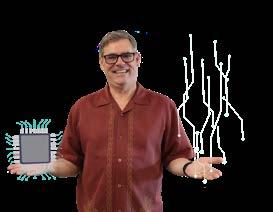
Their approach was straightforward: identify the root cause of failures, address them, and communicate findings to other groups to fix the problem together. Despite the routine nature of the work, Taylor found enjoyment engaging with friends at a college club.
Scan the QR code to read
Shveta Bagade, variety of industries
After obtaining a degree in materials engineering, Bagade initially worked in research and development, went on to pursue a career in tech service and continued in sales and marketing. Following her marketing job, Bagade moved to California and became a full-time mom for 20 years. During that time, she volunteered at different high school college and career centers, such as at Prospect High School.

“I really enjoy working with teenagers,” Bagade said. “I find it fulfilling to be able to help students find their place and kick off their career.”
Scan the QR code to read more.
Crystal Isola, entertainment industry
Before taking on a formal role in education, music department lead and choir teacher Crystal Isola took on numerous roles in the entertainment business. Isola’s work was noticed by numerous directors who hired her for other educational programs. One of the projects she worked on was a career day-styled program where she would interview different people all over Edmonton about their careers.
“This project was very cool because it was like being a journalist,” Isola said. “I wrote my own questions and interviewed different people from all walks of life.”
Scan the QR code to read more.
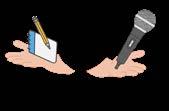
Terri Fill, industrial & organizational psychology industry

Though her passion for English has always remained a part of her, English teacher Terri Fill had previously worked in the Industrial and Organizational field, which uses research methods to improve work performance, communication and employee satisfaction.
Scan the QR code to read more.

09 FEATURES April 1, 2024
SCAN ME Read more at lhsepic.com
GRAPHIC ILLUSTRATION BY RIKI MURASE
PHOTO BY NICOLE GE GRAPHIC ILLUSTRATIONS BY IRENE HWANG, MEADOW SHEN AND ALEXANDRA WU
PHOTO BY NICOLE GE GRAPHIC ILLUSTRATIONS BY IRENE HWANG, MEADOW SHEN AND ALEXANDRA WU
Striking a chord with the Kickkats band
BY QIANZI LOO
Arising from a common love for music, seven students banded together in a blend of guitar, bass strings and syncopated drum beats, overlaid with rich melodies. Over the past year, the student band Kickkats has performed at various locations, ranging from the Oakmont Senior Center to ASB’s recent Coffeehouse Talent Show.
The group currently consists of seven members who all contribute in unique ways: guitarist Sriman Ratnapu, vocalist and guitarist Jayadev Ghanta, guitarist Aryan Patnaik, pianist and vocalist Daniel Wan, trumpeter Vineeth Yenduri, bassist Jonathan Bruennert and drummer Bruhath Batla. Of these, all the members are juniors except for Batla, who is a sophomore.
The concept of forming a band had always lingered in Ratnapu’s mind, starting with their unofficial cameo at ASB’s Coffeehouse Talent Show in February 2023, where Ratnapu, Ghanta and Batla presented a cover of “Riptide” by Vance Joy. Later that summer, they also had a small performance with some of the current band members at the Oakland Zoo for Ratnapu’s summer internship.
“We all had a common goal and wanted to perform at more places,” Ghanta said. “So then we decided, ‘Why don’t we just keep going together?’”
From the initial trio, they quickly expanded to the current 7-member band.
After finding band members, they worked on brainstorming a name for the band, and as ideas escaped them, Yenduri proposed “Punt Cats,” after his dislike for cats. Eventually, the band latched onto the inside joke and settled on the catchy stage name of Kickkats, which was influenced by Ghanta’s unrelated love for the popular chocolate wafer Kit Kat.
Kickkats officially made their first appearance at the Oakmont Senior Center on Oct. 21, 2023, where they played “505” and “Do I Wanna Know?”
by the Arctic Monkeys, which they posted on their Instagram @kickkats_official. While they had wished that certain aspects of the performance had been better, it still marked a memorable start to their band journey.
With Christmas festivities coming to a head, Kickkats met at Ratnapu’s garage to rehearse a cover of the Christmas classic “Feliz Navidad” by José Feliciano, which is when Kickkats really started to come to fruition.
“Some of the initial obstacles were band member attendance and trying to coordinate everyone’s availability,” Patnaik said. “But we were able to work around that by having only a few rehearsals before each performance. We’re also glad to have Sriman’s garage as a place to rehearse.”
The diversity of Kickkats, however, posed a challenge for band members trying to learn unique individual parts. As the sole trumpet player, Yenduri needed to remain focused on his own parts while being mindful of the general intensity of trumpet sounds over other instruments. Some members also sought to expand their musical knowledge by taking on new challenges.
“I began to learn the bass for Kickkats, starting with learning the bass notes on the piano before shifting them over to the bass,” Bruennert said. “I’ve been practicing for
five months now and watched tutorials online to learn the fundamentals.”
Following a handful of performances outside of school, Kickkats soon found the opportunity to perform together at the Valkyries show in January — their first school performance with most of the members — displaying their unique renditions of “Burn the House Down” by AJR and “I Ain’t Worried” by OneRepublic.
“Kickkats had asked me for some advice on potential places or venues where they could play, and they invited me to watch their performances, including the one at the Valkyries show,” science teacher Issac Pallone said.
Although they had a shift in audience compared to other outside performances, the band members quickly adjusted as they all had some form of experience in orchestra and band. Being together for practices and performances so often also strengthened bonds between the members.
The Kickkats’ most recent success occurred at the ASB’s Coffeehouse Talent Show on March 1, where Kickkats showcased “Seven Nation Army” by The White Stripes and “There’s Nothing Holding Me Back” by Shawn Mendes. Despite lacking a drummer during the early stages of their rehearsals, they were able to find a student to help fill the role for the night. Senior Nimay Shankar joined Kickkats as a drummer for the two songs as the cafeteria filled with students nodding their heads and tapping along to the energetic beats.
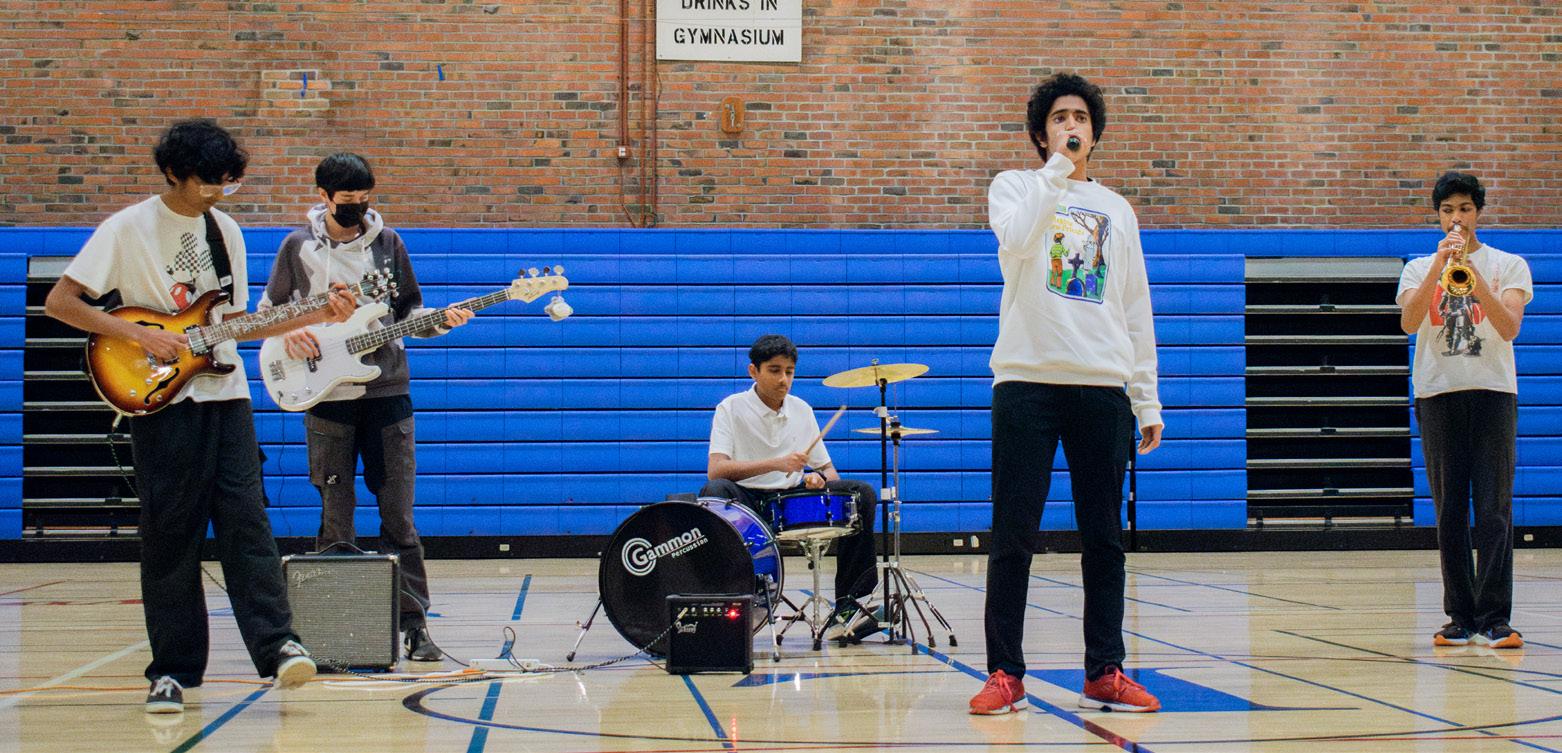

“Their music style wasn’t something I expected, but I recognized the songs they played and thought they did a great job,” Pallone said.
For now, Kickkats plans to focus on producing original music, adding variety to their usual music covers, in hopes of creating something uniquely Kickkats. The group also hopes to continue their outside performances and is considering one at Santana Row in the future if they have the opportunity.
“In the end, we just hope to have fun by creating music as a group and sharing it with the wider community,” Venduri said.


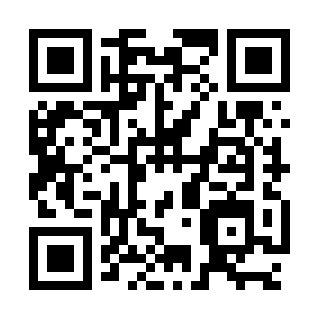

s t t u r n a r o u n d t i m e w i t h a f f i l i a t e d d i g i t a l d e n t a l l a b E a s y t o u n d e r s t a n d t r e a t m e n t p l a n s t h r o u g h v i s u a l i z a t i o n D i g i t a l i z a t i o n s a v e s y o u t i m e a n d m















April 1, 2024 FEATURES 10
O n e - s t o p d e n t a l c a r e f o r a l l y o u r f a m i l y D D S , C o l u m b i a U n i v e r s i t y C o l l e g e o f D e n t a l M e d i c i n e B S , C o m p u t e r E n g i n e e r i n g , U o f I l l i n o i s a t U r b a n a - C h a m p a i g n G o o g l e 5 - s t a r r e v i e w s f o r D r K i m a n d t h e s t a f f s F r e e c o n s u l t a t i o n & X - R a y w i t h D r . J o s e p h K i m 1 0 4 4 0 S . D e A n z a B l v d . D 1 , C u p e r t i n o , C A 9 5 0 1 4 ( 4 0 8 ) 6 4 2 1 7 7 5 S h o r t c h a i r t i m e t h a n k s t o d i g i t a l i z a t i o n F a
o n e y W i s d o m T o o t h S p e c i a l * R e f e r t o t h i s a d f o r 5 % O F F D e n t a l I m p l a n t O n e o f t h e m o s t e x p e r i e n c e d d e n t i s t s i n t h e B a y A r e a w w w s m i l e p l a n t d e n t a l c o m O r t h o d o n t i c s I n v i s a l i g n c e r t i f i e d p r o v i d e r
Kickkat members and juniors Sriman Ratnapu, Jayadev Ghanta, Vineeth Venduri and Jonathan Bruennert and sophomore Bruhath Batla performed at the Valkyries show in January. Not pictured: juniors Daniel Wan and Aryan Patnaik.
PHOTO BY LILLY WU
The revolutionary, digital frontier of CGI
BY CLAIRE GUO AND YVONNE WU
The theater darkens and lights flash across the faces of a crowd of entranced movie-goers. In mere seconds, the room is transformed into a desert oasis, with fantastical fight scenes and magical battles, monsters plucked right from a fairy tale and landscapes that seem to live and breathe. This is the power of computer-generated images, or CGI, which is the application of computer graphics for creating images in two dimensions and three dimensions, used widely within the film, art and video games industries.
CGI is a process that can create simple things like shapes in complicated environments that mimic reality with the use of specialized software. Many movie directors and film creators use software platforms such as Blender, Unreal Engine, Maya and Cinema 4D to create their CGI. CGI is generally categorized as either 2D CGI or 3D CGI. 2D CGI is widely used for creating flat, drawn objects, backgrounds and effects, while 3D animation generally creates more complicated figures and environments in video games, simulations and more. A way to visualize this difference is to understand that 2D CGI was used to create Disney classics like “The Princess and the Frog,” and 3D CGI was used to create newer movies like “Encanto” and “Moana.”
To create a CGI character, a film producer would first create a 3D model of the character, then create a digital skeleton to model it for motion. Subsequently, the 3D model is animated on the computer and matched to the live-action film. Similarly, computer-generated effects are procedurally animated, lit, rendered and composited to match the rest of the film.

CGI was first introduced in the 1958 live-action film, “Vertigo,” in the opening sequence animation. John Whitney, a pioneer of the age, experimented with anti-aircraft technology from World War II to bring about a feeling of vertigo — a sensation of motion or spinning that is often described as dizziness — with spirals and lines that created intricate flowering designs on a black background. Soon after, films such as “The Sine Curve Man,” “A Space Odyssey,” “Westworld” and “Star Trek IV: The Voyage Home” introduced novel concepts, including the digital morphing of faces, blending digital animation and live-action acting and 3D morphing. CGI was quickly becoming an indispensable and increasingly popular tool for directors and filmmakers.
The use of green screens was popularized in the late 1800s following George Albert Smith’s use of a double exposure technique. He originally used a black background cloth instead and replaced parts of images to incorporate a separate background. Modern filmmakers have replaced black with green because of its stark contrast with the color tones of characters and accessories on camera.
In 1999, the movie “The Matrix” made a big breakthrough within the world of CGI. With the use of multiple cameras, film directors Katsuhiro Otomo and Yuen Woo-ping created the famous airborne fight scenes and bullet-dodging slow-motion shots. Then, in 2001, the first photo-realistic human character was created: Dr Aki Ross, the heroine of Hironobu Sakaguchi’s sci-fi film; in 2004, the first motion-capture feature film, “The Polar Express,” was released. In 2009, “Avatar: became well known for using Weta Digital’s notable new facial capture technology to create characters that were larger than life yet full of emotion. In the end, the film was composed of 60% CGI, which created the digital characters and beautiful environments. This period of time saw massive development e in CGI techniques and increase in use.
“Over the course of my career, there have been noticeable advances in technology and the quality of CGI has drastically improved,” Hamer said. “For example, compare the performance of a fully CGI character like ‘Golem in the Lord of the Rings’ (2001) with earlier attempts to create a computer-generated character with realistic human movements like the T-1000 in ‘Terminator 2’ (1991). That’s a lot of progress in one decade for this technology, and it keeps getting more advanced each year.”

“CGI opens up new worlds of storytelling and provides an immersive experience that wouldn’t otherwise be possible.”
Mark Hamner, flm and animation instructor at De Anza College
“CGI opens up new worlds of storytelling and provides an immersive experience that wouldn’t otherwise be possible,” said Mark Hamer, a film and animation instructor at De Anza College. ” Since the beginning of cinema, moviemakers have used special effects to expand the possibilities of film as a storytelling medium.”
Unfortunately, a common complaint of early CGI revolved around how unrealistic it was in the mid-1900s. Viewers often spotted poorly-developed CGI, which diminished their perception of how helpful the tool could be. Additionally, the tools used to create CGI were still relatively new, so characters could look unnatural, with expressions that didn’t feel humanoid. However, the advancement of technology, computer image analysis and higher power technologies all contributed to the rapid transformation of the quality of CGI effects.
In the movie, “Tron,” from 1982, visual effects artists were able to achieve the look of the characters illuminated by having actors wear black-and-white costumes and film in black and white video. With the combination of physical effects and the abilities of advanced computer image simulation, the film displayed exceptional skill and breakthroughs in CGI abilities.
Now, in 2024, theaters show CGIincorporated movies such as “Dune 2” and “Avatar: the Way of the Water.”
“Dune 2” was lauded for its fight scenes and the fact that it was almost impossible to tell what was and wasn’t CGI, with the general public praising the seamless integration of the special effects. Director Denis Villeneuve aimed to shoot as much of the movie in-person, filming a lot of the scenes in a Jordan desert. Meanwhile, “Avatar: the Way of the Water” was praised by movie critics and audiences alike for a different reason: the realistic and expressive digital characters, but also the fantastical and magical environment. Writer and director James Cameron wanted the actors and the scenes to look as real as possible, so the crew implemented underwater performance capture to do so. The process tracks live movements of actors on screen, and during the editing process, the team integrates CGI into the scene.
“I would say that earlier the Avengers movies like the Iron man movies were pretty groundbreaking in CGI, especially with how they made Iron man suits,” senior Film and Photo Society President Gio Cabaltica said.
Now, the film industry has grown increasingly reliant on artificial intelligence. From generating scripts to predicting box office successes and fine-tuning CGI effects, the possible applications for AI in film are diverse. The industry’s heavy dependence on AI for CGI has sparked outrage within the community with members of the SAGAFTRA actor’s union striking. There has been a debate over whether or not works like CGI in films created by AI can be deemed original. Some claim it takes away from the importance of human creativity and art while others support the use of AI as a tool to enhance productivity.


CGI was frst introduced in the 1958 live-action flm, “Vertigo,” in the opening sequence animation. John Whitney, a pioneer of the age, experimented to bring about a feeling of vertigo.

In 1986 “Star Trek IV: The Voyage Home” introduced novel concepts like the digital morphing of face. CGI was quickly becoming an indispensable and increasingly popular tool for directors and flmmakers.
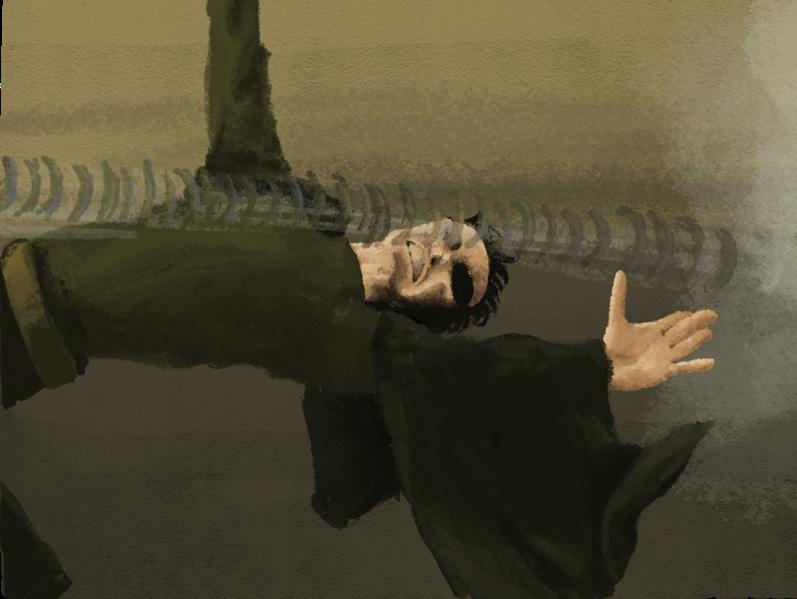
In 1999, “The Matrix” made a breakthrough in CGI. With multiple cameras, flm directors Katsuhiro Otomo and Yuen Woo-ping created the famous airborne fght scenes and bullet-dodging slow-motion shots.
“The stories still need to be good or the audience won’t care,” Hamer said. “We’ve all gone to a CGI blockbuster that ended up being boring. The most effective use of CGI is when it’s used to reinforce a great story.”
Nevertheless, the future of CGI holds promising advancements. Such accurately synthesized videos are possible because of the sufficient base data training sets that are fed to the AI models and the additional plethora of interactive data that the models receive. Fortunately, the job of VFX artists is not jeopardized by AI because, although AI is good at following directions, it canwnot self-direct. Prompts for AI to alter CGI can only go so far because when it comes to humanlike movements and looks, the employment of VFX artists’ skills are still preferred.


“Dune 2” was lauded for its fght scenes and the fact that it was almost impossible to tell what was and wasn’t CGI, with the general public praising the seamless integration of the special efects.
11 the Epic IN-DEPTH
GRAPHIC ILLUSTRATIONS BY TAEK KIM AND ALEX COTTEREL
Unveiling the truth behind eating disorders
BY CHARLOTTE BOLAY AND LILLY WU
This story contains references to content that may be difficult for those who have experienced eating disorders or are sensitive to topics concerning or related to body image.
Adistressed teenager panics as they take a quick scan around their bathroom. To their disappointment, they find countless strands of hair scattered across the sink, countertops and bathroom floor. Hair loss is one of the many physical symptoms experienced by people battling eating disorders. Eating disorders are behavioral conditions that cause persistent disturbances in eating behaviors and can negatively affect a person’s mental and physical health. Eating disorders come in different forms and can have many causes, all of which greatly impact teenagers and adolescents.
According to the National Comorbidity Survey Adolescent Supplement, about 3% of people will develop an eating disorder sometime in their life. Some of the most common forms of eating disorders include anorexia nervosa, bulimia and binge eating. Anorexia is characterized by reduced food intake due to a fear of being overweight and is often associated with a distorted body image. Those suffering from bulimia tend to purge after eating to avoid weight gain through self-induced vomiting, laxatives or over-exercising. Binge Eating Disorder is characterized by the intake of a large amount of food over a short period of time.
to Eating Disorder Hope, 33% of men have used unhealthy behaviors at one point as a method of
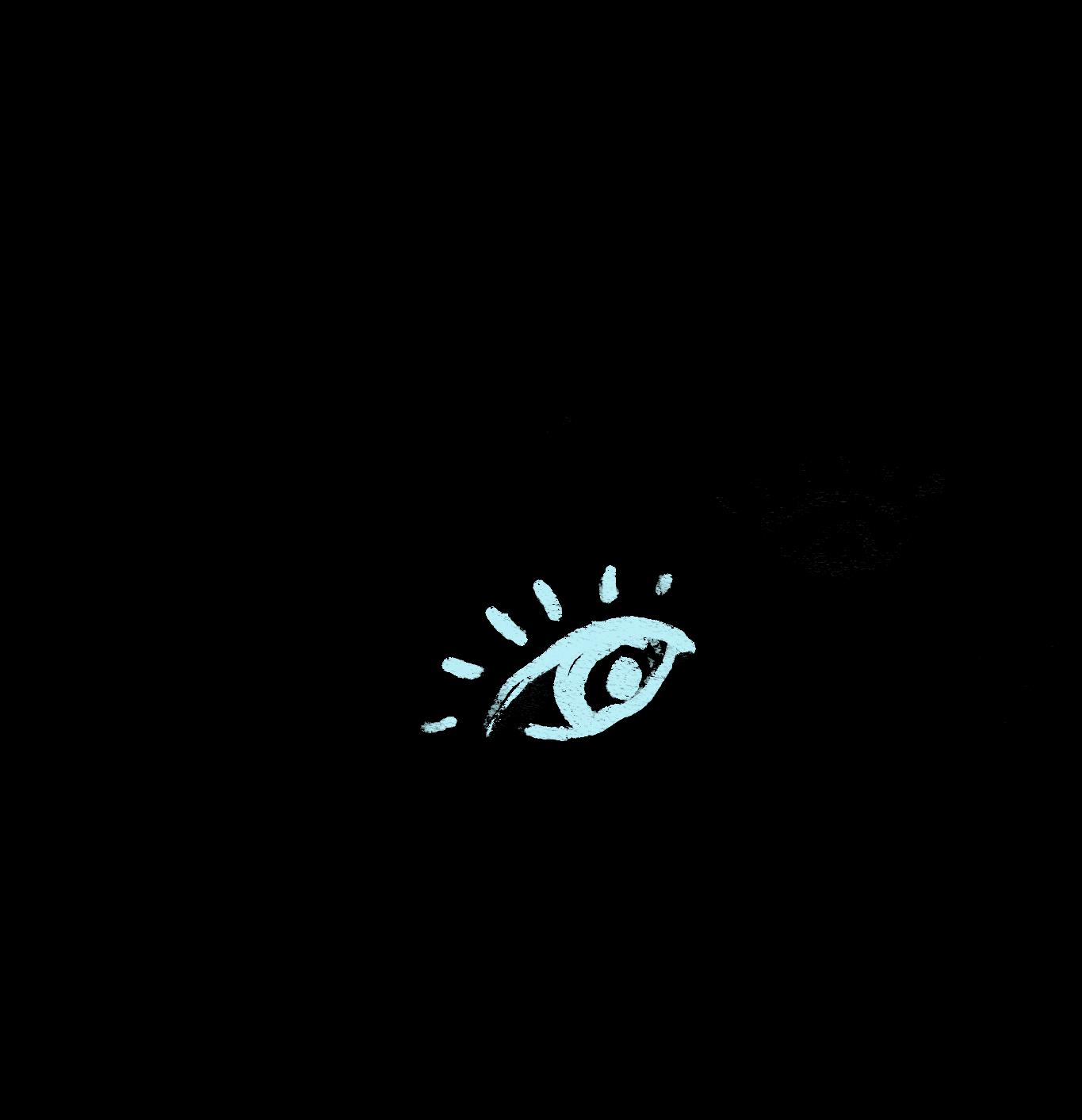
These behaviors can manifest in many different ways, each affecting a person differently. For example, orthorexia is defined as a person demonstrating a fixation on eating only “pure” food such as dairy and grains while avoiding artificial or processed foods. People with Avoidant/Restrictive Food Intake Disorder demonstrate extreme selectivity with food intake and limit food based on factors such as smells, colors, textures and tastes. Pica is a disorder that describes people with the compulsion to eat inedible objects, including rocks, paper and crayons. These eating disorders drastically affect the mental and physical health of affected individuals.
“There are different categories for eating disorders such as anorexia and bulimia, but there are also others that a lot of people don’t know about,” school-based therapist Jenna Starnes said. “The Avoid/Restrictive eating disorder is less about body image and more about being a picky eater and having an aversion to particular textures or tastes. With this eating disorder, it really starts becoming a problem when you see nutritional deficits.”
A key aspect of eating disorders is the relationship the individual has with food. People suffering from binge eating disorder often turn to food as a method of feeling comfort. However, food is meant to be fuel for one’s body, not a coping mechanism to deal with stress.
“A healthy relationship with food is one where you care about your nutrition and what you eat, but you don’t spend every second of your life thinking about it,” Culinary Arts Club public relations officer Becca Han said.
All irregular eating behaviors can bring about negative effects on the body, both mentally and physically. Some of the common effects include hormonal imbalances, weakened immune systems and obsessive behaviors. Anorexia in particular often leads to thinning of the bones, low blood pressure or brittle hair and nails. Frequent selfinduced vomiting, a symptom of bulimia, can lead to tooth decay, swollen salivary glands or organ failure. In the long run, bulimia could also result in hormonal imbalance, acid reflux and troubles with regulating body temperature.
The NCSAS also states that the prevalence of binge eating disorder was twice as high among females than among males, with the rates being 1.6% and 0.8%, respectively. However, challenges faced by men who suffer from eating disorders manifest in severe forms as well. According


“There’s no one specific thing that causes eating disorders because there are a number of layers,” Starnes said. “There’s also a correlation to things such as perfectionistic thinking, rigidity and high parental criticism. Still, every individual is different, and it depends on what type of eating disorder they are dealing with.”
Among high school students, body image has become a prevalent issue, as many focus on the way their body looks or the exact scale reading of their weight. Many turn to social media, which can emphasize insecurities. With phones and electronic devices so close within reach, it is easy to make comparisons with celebrities and online influencers. Often, individuals with thin, fit or conventionally attractive bodies are used as inspiration for the “perfect” body, which can incite competition and unrealistic expectations.
“We are all a little bit addicted to our phones these days, and the more time we spend using social media the worse it gets,” Han said. “We see these pictures of models and influencers, and even though sometimes they’re editing their photos, it still results in negative body image.”
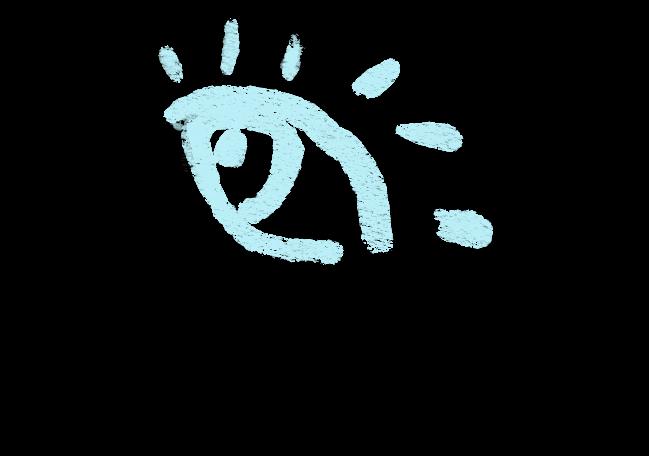
The expectations of some sports are major reasons behind these actions, as Eating Disorder Hope also states that up to 45% of female athletes and 19% of male athletes struggle with eating disorders. These disorders among athletes often stem from their unique relationships with nutrition and exercise, and the results of these conditions could eventually negatively impact the performance of an athlete. Female athletes in gymnastics, dance and figure skating as well as men in wrestling, equestrianism and body-building are more likely to have a large focus on controlling their food intake.
“During wrestling season I need to cut down on the food I eat to maintain my weight to fit in weight classes,” Srivastava said. “While I was cutting, I was exhausted during the entire school day and couldn’t pay attention to my homework.”
People suffering from eating disorders often seek out resources such as therapists and counselors. Eating disorder helplines are also useful in providing someone for people to speak to about their problems. Regular medical checkups for monitoring one’s physical health are essential to recovery, as well as developing healthy coping mechanisms to deal with stress. Having a strong support group consisting of friends and family members will help with providing a sense of comfort and belonging. In 1986, a group of about 40 people from three different countries gathered to discuss organizing an international Eating Disorders Awareness Week. Generally held in late February or early March, the annual campaign aims to educate people about eating disorders and provide hope and support for the affected individuals.
“What helped me the most was learning from people who had similar experiences but have recovered rather than looking at textbook solutions,” junior Kelly Chu said. “Hearing from real experiences of people who went through the same struggles helped me understand that my eating disorder wasn’t necessarily related to body image, but it more so stemmed from underlying issues.”
To support loved ones who may be struggling with eating disorders, people can create healthier environments by refraining from talking about bodies and food in general.
“We should stop making so many of our comments and compliments based on appearances,” Starnes said. “It’s best to just not talk about people’s bodies and how much or how little you ate.”
Due to the prevalence of teenagers developing eating disorders, it is important to be aware of their negative effects. To combat these issues, there are many resources that one can turn to for help.
“I want people going through these problems to realize that they are not alone,” Han said. “At the end of the day, you are going to get out of it and there is a solution.”
GRAPHIC ILLUSTRATION BY ALEX COTTEREL
April 1, 2024 IN-DEPTH 12
This is satire: Literature’s wicked grin
BY ASHLEY HUANG AND SUSANNA TANG
Satire is a technique used by writers to expose and criticize the norm of an individual or a society, employing humor, irony, exaggeration or absurdity to ridicule. It pokes fun at social issues, often with a goal to drive social change. George Orwell’s “Animal Farm” is a perfect example of satirical literature: Orwell imbues irony and absurdity into a story about mistreated farm animals to criticize the Russian Revolution and the subsequent Stalinist era.
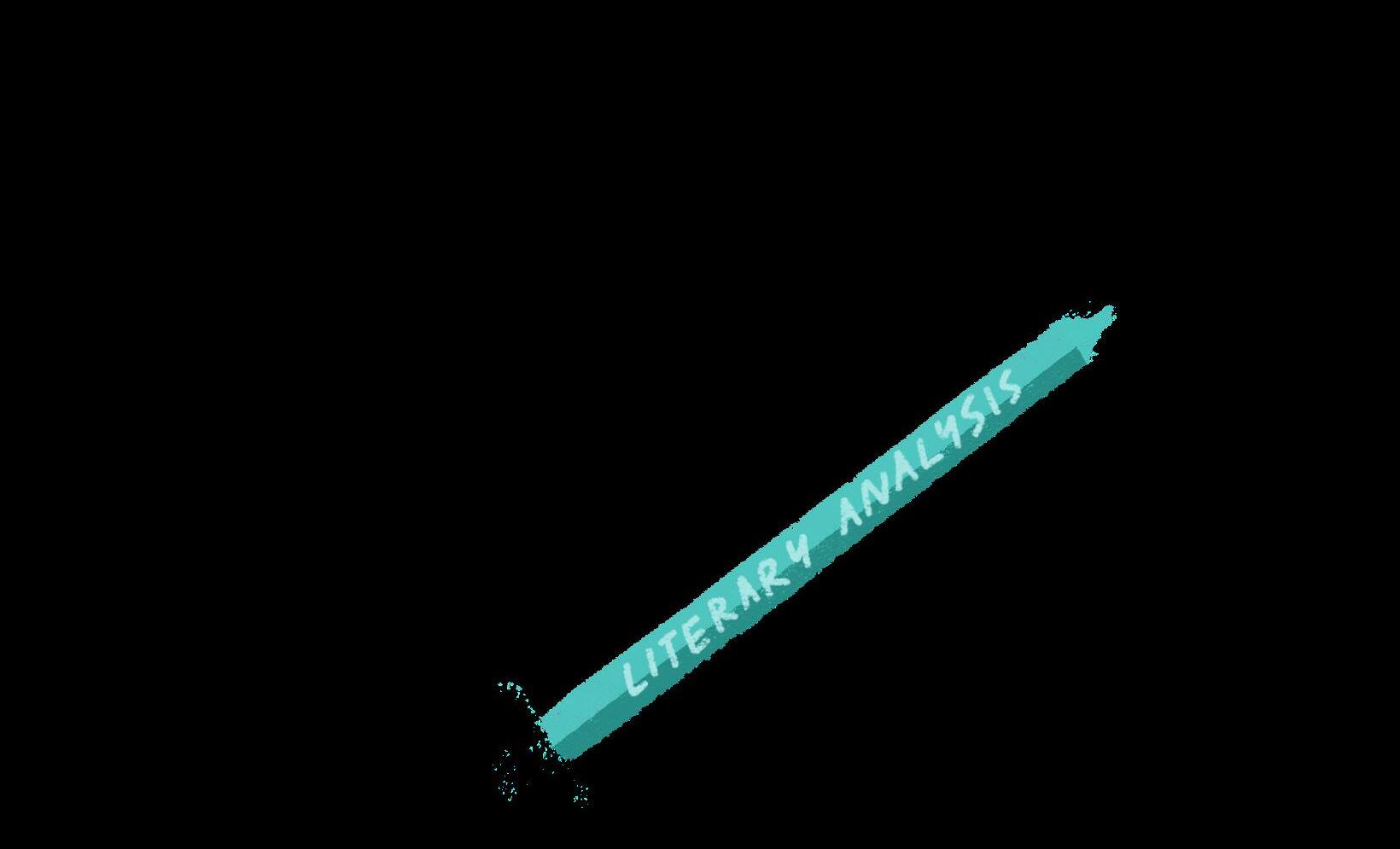
“Satire may not necessarily offer a solution,” English teacher Terri Fill said. “But it gets us to notice something about ourselves or our society by ridiculing it and bringing it to our attention. It causes us to reflect and hopefully think of our own solutions.”
The origins of satire can be traced back to ancient Greece, where playwrights like Aristophanes mocked political figures and societal norms using satire in theatrical comedies. During the Renaissance, authors such as Geoffrey Chaucer and Desiderius Erasmus addressed corruption in the Roman Catholic church and government with satirical literature. Jonathan Swift’s “A Modest Proposal” suggests the eating of Irish babies as a solution to poverty, using absurdity to highlight the inhumanity and indifference of British policy toward the Irish poor. French satirists of the same period, such as Voltaire, used juxtaposition to develop incongruity of the brutal realities in life with Gottfried Wilhelm Leibniz’s optimistic philosophies, ultimately to criticize societal and religious hypocrisies.
The power of satire lies in its ability to engage readers with thought-provoking absurdity or humorous dialogue, even sustaining attention from audiences with opposing viewpoints. As an author reels the reader into developing connections with

characters or story plots, satire serves to prompt reflection on serious subjects in a manner that is entertaining and lighthearted enough to not come off as overly direct.
“...’Gentlemen,’ concluded Napoleon, ‘I will give you the same toast as before, but in a different form. Fill your glasses to the brim. Gentlemen, here is my toast: To the prosperity of The Manor Farm!’

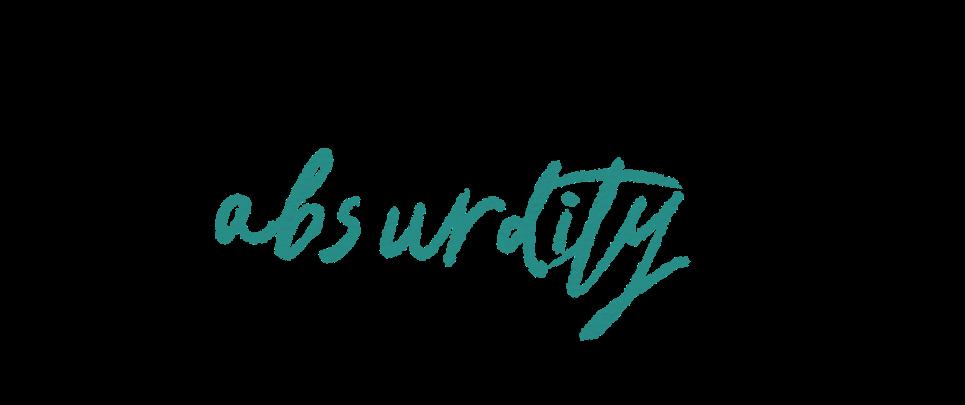
“Satire ridicules something about ourselves or our world,” Fill said. “Ridiculing whatever needs to be changed in society is a way to get people to laugh at it and realize that they don’t want to be part of it. Nobody wants to be ridiculed.”

There was the same hearty cheering as before, and the mugs were emptied to the dregs. But as the animals outside gazed at the scene, it seemed to them that some strange thing was happening. What was it that had altered in the faces of the pigs? Clover’s old dim eyes flitted from one face to another. Some of them had five chins, some had four, some had three. But what was it that seemed to be melting and changing? Then, the applause having come to an end, the company took up their cards and continued the game that had been interrupted, and the animals crept silently away.
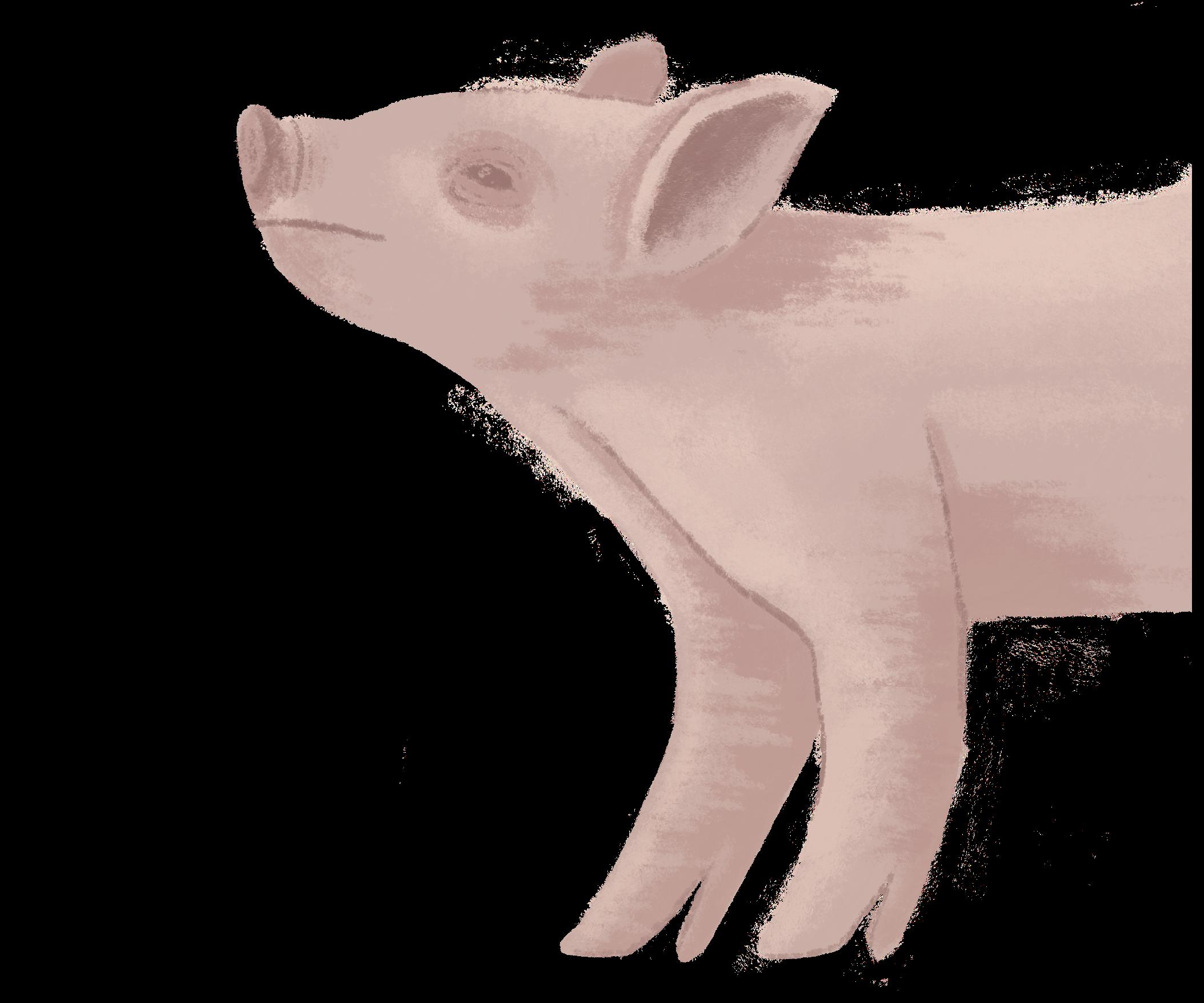
The three commonly recognized rhetorical tools used in satire are exaggeration, irony and catharsis. Exaggeration emphasizes flaws of its subject matter to bring attention to its ridiculousness. Irony and sarcasm — saying one thing but meaning another — can indirectly convey a message by mocking the gap between reality and perception. By poking fun at societal tensions, satire can offer a sense of catharsis for those who may feel oppressed by these tensions.
“If you pick up a book and it doesn’t really interest you, then you’re not gonna read it, right?” junior Daniel Wan said. “But

if it can make you laugh and draw you into the story, then you’re gonna want to read it more.”
But they had not gone twenty yards when they stopped short. An uproar of voices was coming from the farmhouse. They rushed back and looked through the window again. Yes, a violent quarrel was in progress. There were shoutings, bangings on the table...”
In education, satire is applicable in history and government classes when dealing with political cartoons. For example, “The Bosses of the Senate,” an American political cartoon by Joseph Keppler, illustrates the overpowering influence of big business on the United States during the late 19th century by portraying industrial magnates as gigantic figures looming over the Senate chamber. The senators are shown as dwarfed and overshadowed by colossal businessmen, suggesting that legislative decisions were heavily biased in favor of big business.
“Political cartoons are often satirical by the way they are drawn; most of them only use short phrases of text,” history and government teacher Mike Williams said. “However, you have to be careful about using satire because it may have a particular political point of view that might not sit right with others. For this reason, teachers are encouraged to teach political cartoons, which may contain satirical messages, in a way that proper background or context is given first, or during a lesson in a way that provides for objective analysis on overall understanding.”
Aside from history, satire is also largely used in literature. In the satirical novel, “The Pamela Papers: A Largely E-pistolary Story of Academic Pandemic Pandemonium” by Nancy McCabe, a writing professor at University of Pittsburgh at Bradford, McCabe satirizes the chaotic realities of academic life during the COVID-19 pandemic.
“I would not have tried to write a satire at any point in my life before this novel because I knew that it was hard and people could misunderstand it,” McCabe said. “If you’re not funny enough, if you don’t hit the right way, people could miss the satirical element. Everything that was going on in my workplace was so absurd, it seemed like the best way to write about it was by highlighting that absurdity. So the satire evolved from there.”
The novel satirizes the sudden shift to digital platforms, the struggle to adapt teaching methods and the complexities that educators and students face. By exaggerating these elements, McCabe offers a humorous yet insightful critique of education’s readiness and response to disruptions.
AP Language and Composition classes also explore satirical literature in rhetorical analysis. The extent of satirical works’ absurdity can cause great offense if not interpreted correctly, making satire a crucial
genre to be able to identify and analyze.
“If you don’t hear the tone, you may miss the point, and you might even misinterpret the entire passage,” Fill said. “So it’s very important to hear the tone in order to correctly interpret the message.”
Satire provides an engaging platform for individuals to initiate change with their voices. In stand-up comedy, comedians like senior Aakash Choudhary use satire to present serious issues in a comedic light, inviting audiences to reflect on these topics without the weight of direct confrontation. This approach not only makes complex subjects more accessible but also encourages listeners who might otherwise avoid such discussions.
“People resonate more with satire than they do with fake political outrage you might normally see in the media,” Choudhary said. “When I write my satirical bits, I think of what bothers or amuses me, and how I can take these to the extreme in a comedic fashion.”
Yet, the power of satire does not come without pitfalls. The very aspects that make satire compelling — its use of exaggeration, irony and humor — also render it susceptible to misinterpretation.
In the era of fake news and rapid information dissemination, the line between satire and misinformation can blur, potentially misleading audiences. This underscores the importance of media literacy in society; understanding the nuances of satirical content can help discern its intentions and messages. When sarcasm and exaggeration are misunderstood by audiences who take them at face value, their intentions can backfire and cause confusion or backlash.
“Satire can be impolite; it can be vulgar,” said Erik Fredner, a University of Virginia postdoctoral research associate and lecturer who teaches a satire course. “But its excesses teach us something about society and culture: how far is too far? Social norms are not always written down, and satirists can reveal unwritten answers to that question through their art.”
Despite these challenges, satire present familiar situations in a new light to challenge readers to reevaluate behaviors and societal norms, demonstrating its enduring power to provoke thought and inspire change.
“Satire will always have a place in a world that needs to speak out against injustice, hypocrisy and evil,” Fredner said. “In 2024, satire’s future is looking very bright indeed.”
13 IN-DEPTH April 1, 2024
GRAPHIC ILLUSTRATION BY OLIVIA YUAN
Story continued from front page.
SPORTS the Epic
Running on empty: e consequences of burnout
BY GARY PAN AND ALYSSA WANG
7
a.m. — wake up. 8 a.m. — go to school. Lunch — complete some homework. 4 p.m. to 6 p.m. — school sports practice. 7 p.m. to 9:30 p.m. — club practice. On the drive there, eat dinner. On the drive back, take a quick nap. 10 p.m. — start studying. 1 a.m. — go to bed.
7 a.m. — wake up. Although intensive, these types of schedules are common for student athletes. Dedicated to both academics and their sport, many student athletes juggle school work and practice daily, often sacrificing time with friends or sleep — and as a result, face burnout.
According to Psychology Today, burnout is a state of emotional, mental and often physical exhaustion resulting from prolonged or repeated stress. Burnout occurs in various professions for a variety of reasons; however, it most commonly occurs among those who work in stressful environments and feel overwhelmed by their responsibilities.

psychological recovery. According to a study done by Lucio A. Cunha and Julio A. Costa, elite athletes reported approximately eight hours of sleep per night to feel rested. Due to sports and non-sport-related factors, these athletes often sleep less than seven hours, affecting their performance and mental health. For example, the study showed that runners and judo athletes who only had four hours of sleep the night before had negatively impacted endurance performance and muscle strength. A night with partial sleep restriction also affects athletes’ motor skills that require an increased amount of cognitive focus, such as goalkeepers and tennis players. Moreover, when already on the verge of burnout, student athletes who do not perform as well tend to lose more interest in the sport and eventually quit.
Some individuals may be more resilient to burnout, while others may be susceptible due to various factors including overtraining and high workload.
Acknowledging individual differences and circumstances allows one to find more efficient ways to manage one’s burnout. Managing is not solely a matter of willpower or quick fixes; a weekend getaway or a spa day may provide temporary relief, but addressing burnout requires more sustainable changes in one’s lifestyle and boundaries.
“Taking the time to pamper yourself and take care of your needs is very important when facing burnout,” Zhu said. “These breaks can alleviate overwhelming feelings and help them find the motivation to continue their sport.”

Student athletes, in particular, oftentimes have to deal with both. They juggle hours of school work along with a rigorous amount of hours dedicated to the sport, all alongside external pressure from both parents and coaches. This relentless cycle of practices, games and academic responsibilities leaves little to no time for relationships or adequate breaks. Without the ability and time to rest or recover, student-athletes can feel chronically overloaded and overwhelmed — and in some cases, exhausted from the sport they originally loved.

“The most important thing is for student athletes to be honest with themselves with how much they can handle.”
Rhea Soni, Junior
“High schoolers are often experiencing burnout for the first time, so they don’t necessarily handle it properly,” Athletic Trainer Scott Leveau said. “College athletes often have already gone through high school sports so they already have an experience of it. High school sports act as a trial period to balance your work and social life.”
To consider a specific physical and mental state as being burnout, three main aspects need to be present: exhaustion, cynicism and feelings of reduced ability. Athletes, in particular, experience burnout at a rate between six to 11 percent as reported by the National Institute of Health with the harsh workload and difficult work-life balance being especially hard to maintain.
“A lot of athletes dedicate their lives to their sport, and after constant practices and games without breaks, they expect to continuously improve,” sophomore Jessie Zhu said. “When they are at a point where they don’t feel like they are getting better even after all the work they put into it, they feel like they are failing and become exhausted, increasing the chances of them wanting to give up.”
In addition to the academic and social commitments that student athletes face, they must devote a substantial amount of time to improve their skills and attend training sessions and competitions. These practices, along with the normal stress associated with school life, may increase a student athlete’s risk of experiencing both physical and mental issues that affect their overall health and wellness. Similarly, student athletes face an enormous amount of pressure from their school teachers, coaches and parents. Teachers expect them to maintain their grades and complete all their work; coaches expect them to dedicate themselves solely to their sport and perform well at games; parents expect them to do well at games and get good grades, all while having time to do chores and sleep at a healthy time. Facing all these expectations is extremely stressful for student athletes, and while they are trying to complete all these tasks, they lose time with their friends or breaks and become tired of the somewhat monotonous routine.
“A lot of pressure comes from coaches and parents, but at the same time, they are also very supportive and oftentimes just want to see you succeed,” junior Chloe Chan said. “For me, the main source of pressure comes from myself and the fact that I want to see myself constantly improve, but student athletes need to understand that everyone has their own limits. Taking themselves away from the moment and making time for new hobbies are especially important.”
However, the busy schedule is not the only factor that contributes to student-athlete burnout; nutrition and sleep are significant factors that could improve or worsen one’s mental state. For athletes, often exposed to highintensity training, sleep is recognized as the most important method for physiological and
Similarly, nutrition is becoming an area of increased interest concerning athlete sleep and recovery. An athlete’s diet depends on several aspects, including the number of hours they practice, their goals and their environment. A healthy and balanced diet not only improves one’s performance but also mental health, due to its impact on brain function, hormones and neurotransmitters. Additionally, a 2019 review published in The American Journal of Clinical Nutrition found that increased fruit and vegetable consumption positively impacts psychological health, and daily vegetable consumption reduces symptoms of depression and alleviates feelings of exhaustion and cynicism. Athletes who eat a balanced diet and take proper breaks have decreased chances of experiencing burnout and improved performance during games and competitions.
Although commonly thought of as the same thing, stress and burnout are completely different. Stress is a temporary state of being that is a response to an environmental factor, while burnout is a mental or physical exhaustion caused by prolonged periods of stress or lack of rest. Despite common belief, stress is not always a hindrance; it can promote alertness and productivity. Burnout, on the other hand, does not have these qualities. Long-term effects of this stress lead to burnout which can lead to exhaustion, numbness and a lack of motivation or engagement.
Burnout results in a variety of side effects; however, these side effects are all synonymous with the general idea of exhaustion, anxiety and negative feelings for both the job and themselves. In reality, the side effects do not only affect one’s mental state; physical effects include gastrointestinal problems, high blood pressure, recurring headaches and sleep issues. High schoolers struggling with burnout suffer from a lack of motivation, the ability to focus and even declining grades.
“Students need to prioritize their own well being,” Assistant Professor of Kinesiology at San Jose State University Matthew Bejar said. “Prioritizing yourself doesn’t make you selfish, it helps everyone: your team, your schoolwork, it’s not a zero sum thing. By prioritizing self care and mindfulness, it makes all ships rise.”
Despite common misconceptions, burnout is common and happens regardless of age, profession and gender. One to nine percent of female studentathletes experience high levels of burnout and two to six percent of male studentathletes experience high levels of burnout according to the NCAA. However, not everyone experiences burnout to the same degree.
For student athletes, establishing clear boundaries between their sport, school and personal life can allow them to prioritize self-care and spend time with family and friends. To avoid losing interest in one’s sport and maintain physical and mental well-being, one should avoid excessive training without adequate recovery time or engage in cross-training or other activities to prevent monotony. This can help maintain their well-being without losing interest in the sport. It is also important to recognize that taking longer breaks can be helpful — giving time to experiment with other interests or rekindle a love for a sport will only enhance one’s mental resilience and overall enthusiasm for their sport and other commitments.
“The most important thing is for student athletes to be honest with themselves with how much they can handle,” junior Rhea Soni said. “They shouldn’t put too many things on their plate and should prioritize their relationships with not only their sport, but also their family and friends.”
6-11% of athletes experience burnout, according to the National Institute of Health
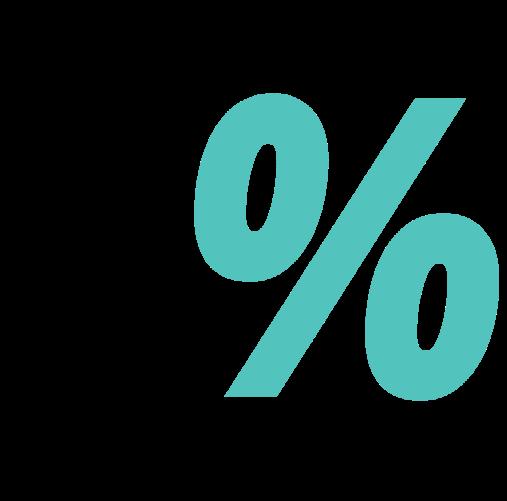
14
GRAPHIC ILLUSTRATION BY CRYSTAL ZHU
COMMITTEd
Adarsh Iyer runs the distance to MIT
BY VIHAAN PATEL
Senior Adarsh Iyer has committed to Massachusetts Institute of Technology for cross country and track and field, continuing his running journey at their top-ranked Division III program. Whether he is running around Lynbrook, in his neighborhood or near the Parker Ranch hills, Iyer has found his passion for long distance running and is excited to run at MIT.
Iyer’s passion for running was sparked when he joined Miller Middle School’s cross country team in sixth grade. After realizing his potential, Iyer started to devote more and more of his time to running, finding time in the morning, after school or in the evenings to go for runs. As Iyer started to train more, he also learned to improve on the mental aspect of running. In the early part of his career, Iyer sometimes experienced thoughts that told him to slow down or stop running while he was racing. Improving the mental part of his
race meant ignoring these negative thoughts and trying to clear his mind while he was running.
“As Lynbrook students, we have a tendency to overthink things,” Iyer said. “However, in distance running, it’s important to not think too much about the race, and just clear your mind and do the best you can.”
As a captain of cross country and track and field, Iyer has also made a profound impact on his teammates, serving as a role model for them and encouraging them to push themselves at meets.
“Usually for track and cross country, we have pasta feasts or team dinners before our meets,” sophomore Akash Anand said. “For invites, we don’t do that, and Adarsh handles all of that by himself. He organizes pasta feasts at his house or someone else’s house. He truly wants to make our team a big family.”
After competing in his freshman and sophomore year, Iyer decided he wanted to run in college at the start of
his junior year, and began to reach out to colleges. He received multiple Division I offers, but decided that he wanted to pursue MIT instead. Although MIT could not guarantee admission to him, he believed MIT was a perfect fit for him, and was willing to take the chance.
“I visited MIT in late September, and in just two days, I knew it was exactly what I was looking for,” Iyer said. “I met everybody on the team, and they were my kind of people.”
While Iyer is sad to leave Lynbrook’s cross country and track and field program, he plans to come back to Lynbrook to visit in the years to come. Iyer is excited to open the next chapter of his career at MIT, and is looking forward to training with his new teammates. During his time at MIT, Iyer’s plans to work hard in order to win a national championship.
Read the full story at lhsepic.com.
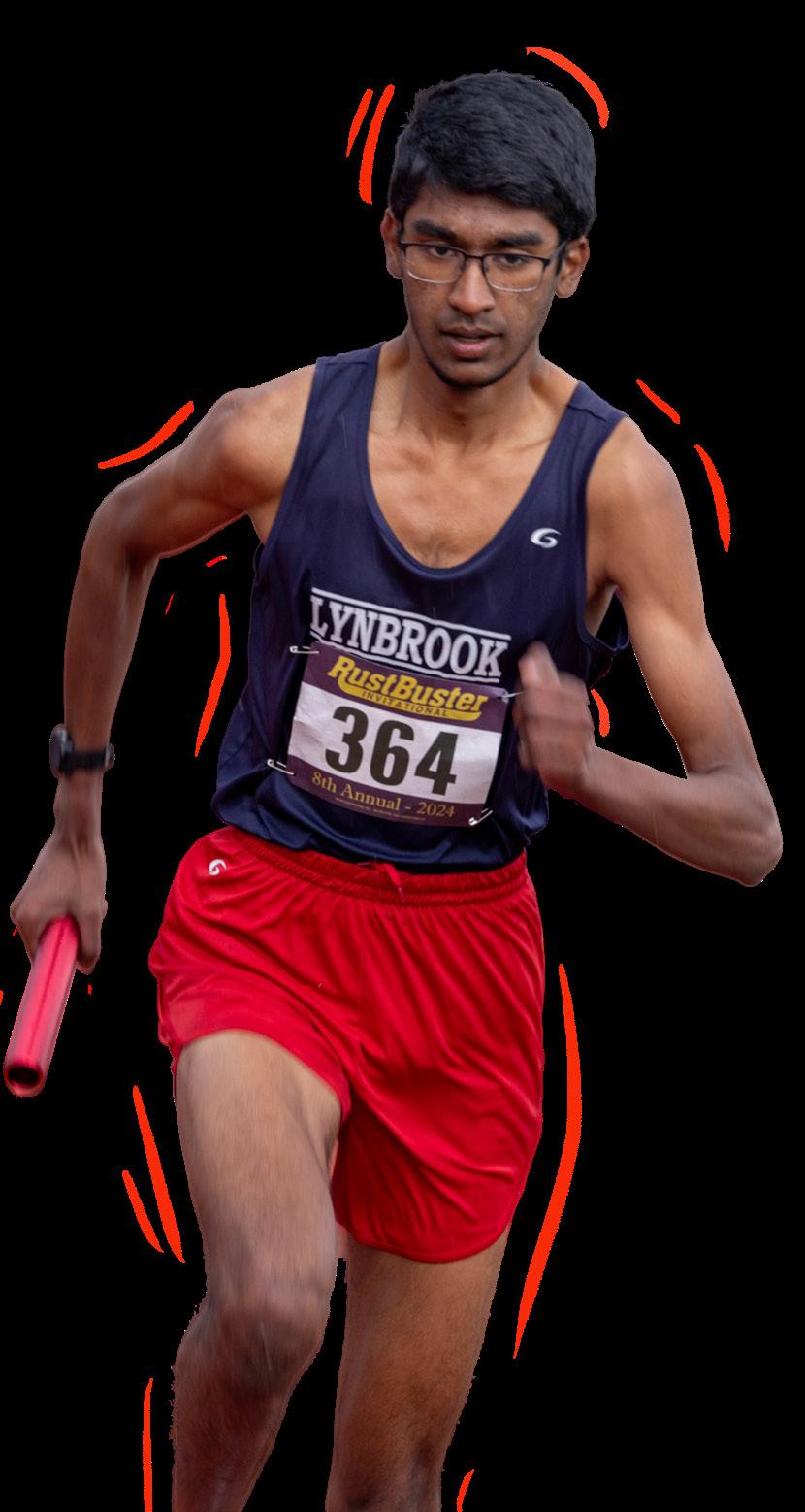
NCAA women’s volleyball rule change sparks controversy
BY APURVA KRISHNAMURTHY
The National Collegiate Athletic Association has shaken the world of women’s volleyball with its recent decision on Feb. 20 to allow double touches by setters in offensive plays. This overturning of the rule has sparked controversy among players and fans alike and will affect collegiate-level volleyball players, presenting a challenge to those who have spent years perfecting their set to adhere to previous regulations.
Representing more than 1,000 colleges and universities in the nation, the NCAA is a nonprofit association that regulates intercollegiate student athletics. The recent ruling is one among a slew of new guidelines that have been released by the oversight panel. The others include permitting two liberos — a back-row player — to switch on and off the court within the same set, allowing more types of small, tightfitting jewelry during gameplay, authorizing interference above the net to be challenged in video review and requiring all protests to be resolved during matches. The final, new rule permits referees to issue administrative sanctions to home teams in the event that spectators encroach playing areas and the host administration fails to resolve the issue.
“I don’t like the double rule; if we allow setters to double, why not just allow hitters to net or liberos to let the ball bounce?” senior and varsity volleyball player Maddie Badger said. “I like the two liberos rule because sometimes liberos can have different specialties, such as serve and receive versus defense, so you can switch out your libero according to their strength.”
In a typical play, a defensive player, who stands in the back row, passes the ball to the setter, stationed in the front right position. The setter then sets the ball toward the hitter and the hitter sends the ball over the net. This accumulates to three contacts with the ball, the previous maximum amount allowed in an offensive play. The new rule allows setters, or whoever has the ball on the second contact, to quickly touch the ball twice without losing a point for the double contact, more colloquially known as “a double.” Had a player done this prior to the rule regulation, the other team would have gained a point for exceeding the 3-touch limit. However, the new leniency towards setting may usher in sloppier technique.
“Plays will become less strict because, before, if you doubled, the play would have stopped and the point would automatically go to the other team,” junior and varsity volleyball player Felicia Huang said. “But now, you can keep playing so other errors can be made.”
This new rule has sparked controversy as veteran players were required to craft the “perfect set” in previous years of training, seeing that athletes

represented by the NCAA fall under the Division I to III categories and have accumulated a great repertoire of skills to reach this point in their athletic career. The new protocol not only undercuts all of the conditioning these athletes underwent to perfect their sets but also forces them to unlearn this behavior to follow formerly unacceptable technique.
“I will be playing in college next year and my college coach said that we will proceed as if the new rule does not exist, because clean sets are an essential part of the game,” Badger said. Double contact can be caused when a setter’s hands are not perfectly even when positioned on the ball. Referees can usually identify an instance of this as the ball will be sent into a spinning motion indicating more than one touch. However, the ball rotating makes it harder for the hitter to act upon receiving the ball.
“With this rule, a whole new set of tactics will be introduced — perhaps strategic ways to spin the ball,” senior and varsity volleyball player Valerie Eng said. “Players can now spin the ball intentionally, which can change the play or shift the trajectory of the ball, making it a lot harder to hit and block.”
Setting during offensive plays is often a catalyst for heated debates among volleyball officials and coaches during tournaments due to confusion of whether or not a double contact was
performed. The NCAA reasoned that the new ruling would bypass such disagreements and offer more consistency throughout games. Moreover, by encouraging the continuation of gameplay, tournaments would foster greater entertainment for spectators and players alike.
“The new rule might make referee calls more neutral because they cannot be biased toward any team and say that the ball spinning was from a double,” Huang said.
On the other hand, the new guidelines could prove to be advantageous for less experienced athletes or non-setters who struggle with proper setting technique. The ruling places less emphasis on the strict three-contact maximum, allowing for room for imperfect playing etiquette.
“A lot of people will still keep their sets clean and keep training the same way,” Eng said. “Regardless, as time goes on, there’s going to be less emphasis on having a good set.”

15 SPORTS April 1, 2024
Be par t of something great!
BY RIKI MURASE
PHOTO AND GRAPHIC ILLUSTRATION
PHOTO USED WITH PERMISSION FROM ADARSH IYER
Video challenges could improve high school sports
BY DAEUN CHUNG
As the clock ticked down in the final quarter, the tension in the gym was palpable. The Vikings were locked in a fierce battle against Silver Creek High School, being only 2 points behind. With just 3 seconds left, it all came down to one last possession. The Vikings caught the inbound pass, taking a dribble and shooting a shot from half court. Projecting a perfect parabola, the ball hit the backboard and dropped through the net. At the same time, one of the assistant basketball coaches noticed something unusual with the game clock: the scoreboard operator never started it. Should the Vikings get the scores or not? Although the referees ruled in favor of the Vikings, nobody could erase unease and dissatisfaction. Thankfully, JV boys basketball coach Jeffrey Bale was filming the game for future practices. He stepped in and reviewed the game videos, calculating the game time.
“The shot was clearly released in time but we felt terrible as the coaches,” Bale said. “So, I went back with the video evidence we had and showed them that the shot was in fact released with one-tenth of a second left. It was nice to have confirmation that the right team had won the game.”

The instant replay should be allowed in high school sports games as well because it will enhance the accuracy of referees’ decisions. On average, referees and match officials make around three to four decisions per minute and over 130 explicit decisions per match. As a referee’s control over the game increases, the scrutiny of the referee’s performance continues to grow, which leads to more pressure on referees to make split-second decisions. Reviewing the footage offers referees a better understanding of game situations, which, in turn, reduces the pressure on referees and allows them to make more accurate calls.
Furthermore, accessing video footage during a game can improve the fairness of the game — ensuring that the game is played on a level playing field and that players compete to the best of their abilities. Additionally, increasing the fairness of the game promotes mutual respect and sportsmanship among players and encourages positive interaction between players. Therefore, fairness is one of the most important values emphasized more in high school sports and for young athletes.
instituted instant replay for review.
“Video challenges have a place but a very limited place in my opinion,” Bale said. “They have the most meaningful effect in playoffs but the vast percentage of games go on without any real controversy that needs additional resources and officials. Also, there has never been a game where I have said the officials were the reason we lost the game or won the game. There are too many variables and I don’t think video challenges will change the outcome of any game in a meaningful way. In addition, it would slow the game down too much, disrupting the flow of the game.”

“Video challenges keep referees accountable.”
In order to combat controversial situations like this one, high school sports associations should allow referees to review footage during and after games. Buzzer beaters, by their very nature, occur in the blink of an eye, leaving room for error in officiating. In the heat of the moment, referees may struggle to observe what exactly happened, occasionally leading them to make incorrect judgments. These split-second decisions can sway the outcome of the game and have lasting effects on the teams involved. Therefore, for a more accurate assessment of a game, referees should be permitted to access footage during and after the game in high school.
Rick Appler, Varsity boys basketball coach
First introduced in 1986 to professional football officiating, video reply has been commonly used to confirm correct rulings or overturn incorrect calls in college and professional sports. According to the National Basketball Association Official Rulebook Rule No. 13 and 14, a field goal made or a foul called with no time remaining on the clock at the end of any period can trigger instant video replay. In addition, teams are allowed to initiate instant replay reviews, or challenges, for events including a called personal foul against their own team, a called out-of-bounds violation or a called goaltending or basket interference violation. However, this is not the case in high school sports. In similar situations, typically, two or three referees present in the game discuss and come up with agreed decisions. After their decisions are announced, it cannot be overruled.
“From this season, at one of our tournaments, we got called for a foul in the last 10 seconds,” varsity girls basketball co-captain Maggie Lam said. “Eventually, the other team got to shoot free throws and that’s the main reason why they won the game. With video challenges, referees may have reversed the foul call and we could play the game out instead of giving the other team free points.”
“In sports, every single point is important to win a game,” sophomore and varsity girls volleyball player Chelsea Li said. “Therefore, fairness in sports is essential to ensure that every point players earn holds true value and I think video challenges would be really helpful to keep the game fair.”
Since viewing footage encourages referees to make decisions based on objective evidence, rather than their subjective interpretations, the officiating process becomes more transparent and enables referees to build trust with players and coaches. In addition, decisions based on footage may reduce the controversy around calls and give results that both teams can accept. In situations like the game against Silver Creek, video challenges can easily erase the controversy around the referees’ decisions because footage can support the referees’ judgment.
“It keeps referees accountable,” varsity boys basketball head coach Rick Appler said. “With the ability to challenge a play, you can have a second look at something that you would have never otherwise had a chance to do. It’s definitely something that I have dreamt of and wished we had but never had the opportunity to.”
Video challenges can also increase consistency in officiating, which is crucial for upholding the credibility of sports competitions and enhancing the integrity of the game. In the 2002 Western Conference Finals, Game 4 between the Sacramento Kings and Los Angeles Lakers happened on May 26, 2002. At the end of halftime, Samaki Walker from the Lakers made a 3-pointer at the end of halftime. Although television replays showed Walker had released the ball after the buzzer went off, the shot was counted and it allowed the Lakers to close the score gap to 65-51. The Lakers eventually won the game 100-99, advancing to the finals. The following season, the NBA

However, even in regular-season matchups, crucial moments can arise where a video challenge could rectify a potential incorrect call that could have significantly affected the game’s result. Also, it is undeniable that officiating errors can occasionally occur and directly impact the result, particularly in playoff games or foul calls. Therefore, leveraging resources that are already available, such as an automated camera system in the gym, Lynbrook can greatly enhance transparency and accountability in sports with little input. Also, other concerns can be easily addressed through carefully implementing and imposing regulations like limiting the number of challenges per team or having the time limit on the review process. By incorporating these measures, video challenges can enhance the accuracy of decisionmaking while minimizing any negative impacts on the pace and integrity of the game.
“Controversial calls by the referees make everyone on the bench angry,” Li said. “The implementation of video challenges will not only prevent future misunderstandings but will also allow everyone to leave the gym without regret.”
Senior Natalie Yang carves her passion on ice
BY AUDREY SUN
As the arena falls silent, senior Natalie Yang glides gracefully across the icy rink. With a final, breathtaking leap, she jumps into the air, her figure under the spotlight as she executes a flawless double turn mid-air. Her blade cleanly slices through the ice surface as she lands with precision.
Yang began her figure skating journey at the age of five, falling in love with the sport after her first visit to a skating rink, guided by her mother. Transitioning from a recreational skater, Yang became more serious about the sport at age ten and started taking private lessons.
“The best part of being a skater is being able to do a lot of cool tricks that impress people like the triple salchow, which is a jump with two and a half rotations in the air,”
Yang said.
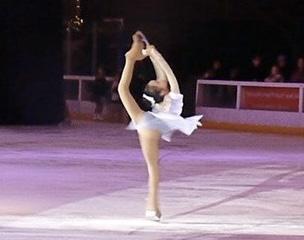
Starting in middle school, Yang began competing individually and would train four days a week. A typical day
for Yang consisted of waking up at five in the morning and traveling to Fremont to train at the San Jose Sharks facility. Her practice sessions included warming up with a few laps on the ice and practicing various jumps. On weekends, Yang engaged in off-ice training, focusing on conditioning to build strength outside of skating. This included exercises such as throwing medicine balls, doing squat jumps and running to improve stamina.
“Since I had training almost every day of the week, I needed to learn how to manage my time well and balance it with my other extracurricular activities,” Yang said.
Figure skating demands extreme determination. One of the most daunting aspects of figure skating is the fear of falling. To overcome this fear, Yang developed a more determined and bold mindset.
“Figure skating has made me more willing to try new things in life,” Yang said.
Yang’s carefree and optimistic mentality has also helped her significantly throughout her journey in ice skating.
“She wasn’t ever stressed out,” Yang’s coach, Sherri
Krahne-Thomas, said. ”She seems to really enjoy skating, and I think that’s one of the big things that really stood out when I was teaching her.”
Yang’s background in dance has proven invaluable throughout her skating journey. Dance enhances a figure skater’s ability to express the artistic side of the sport.
“Dance has taught me to connect with music and express my artistry better,” Yang said.
On the other hand, competing in Chinese dance, Yang developed strength with skills such as front flips and aerials. The flexibility she gained from dance has also helped her in executing complex moves on the ice.
“All that dance she did played a big part in her skating,” Krahne-Thomas said. “She’s got this great mix of strength and flexibility, which just makes her naturally talented.”
Aside from skating competitively, Yang also teaches figure skating at Cupertino Ice Center on Saturdays. Once Yang turned 16 and was legally allowed to start working, she applied for the job right away, excited to share her passion for the sport with others. Yang, teaching both group and private lessons for beginners, adjusts her approach for different students; some are visual learners, while others learn better through verbal instructions.
As Yang heads off to college, she plans to join the ice skating team and continue pursuing her passion for skating.
“I plan to continue skating after high school,” Yang said. “I love meeting new people and especially bonding with others who have the same interests as me.”
April 1, 2024 SPORTS 16
Senior Natalie Yang executes a Biellmann spin at the 2019 fgure skating Crystalline Showcase.
GRAPHIC ILLUSTRATION BY SARAH ZHANG
PHOTO USED WITH PERMISSION FROM NATALIE YANG

 BY ASHLEY HUANG AND SUSANNA TANG
BY ASHLEY HUANG AND SUSANNA TANG





















 BY EILEEN ZHU//IN MY OPINION
BY EILEEN ZHU//IN MY OPINION
















































